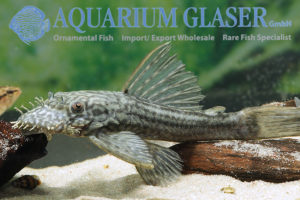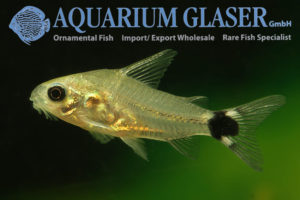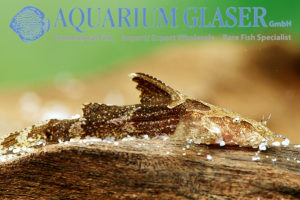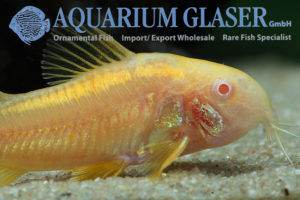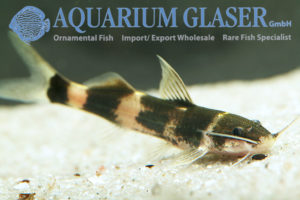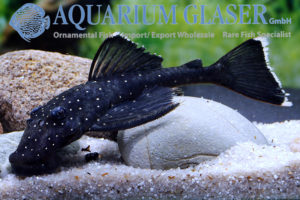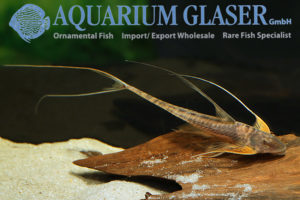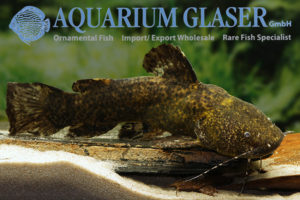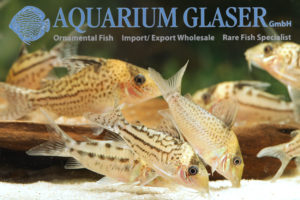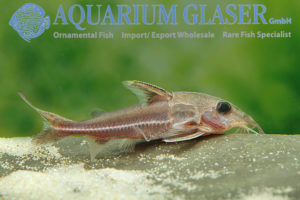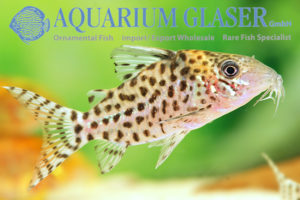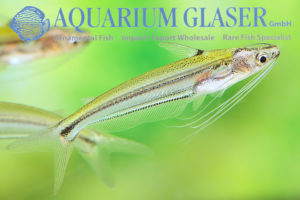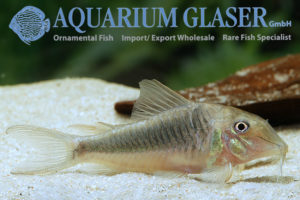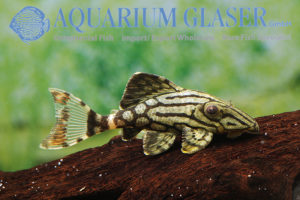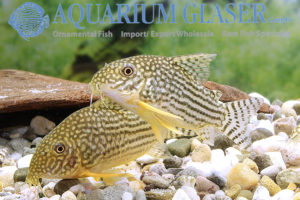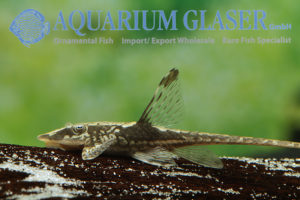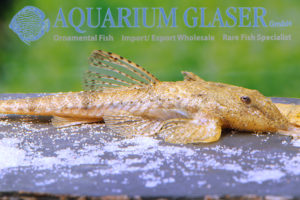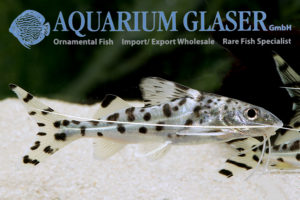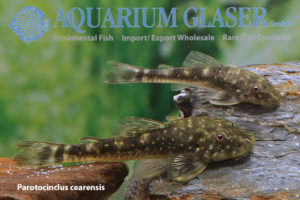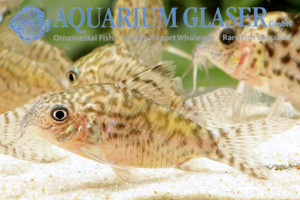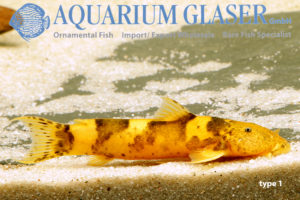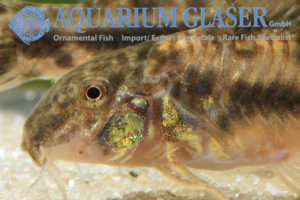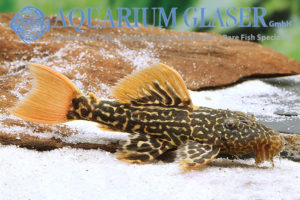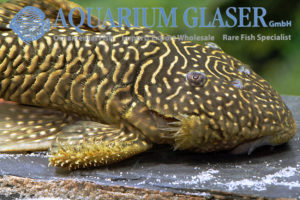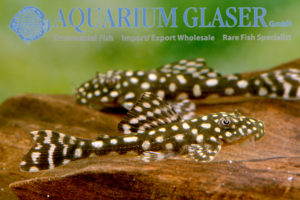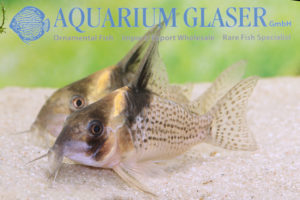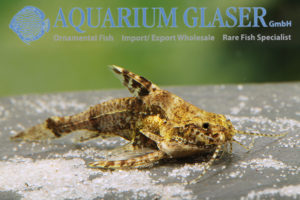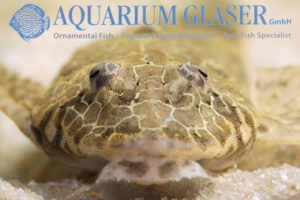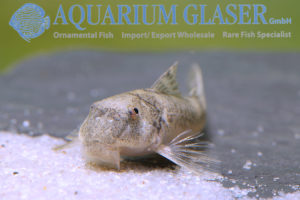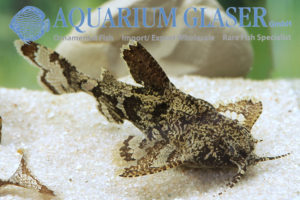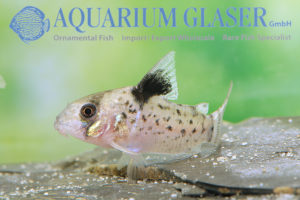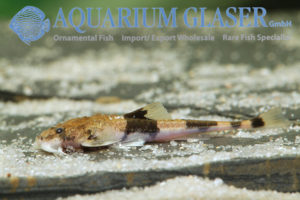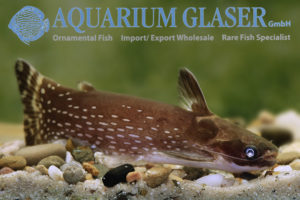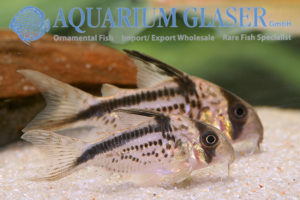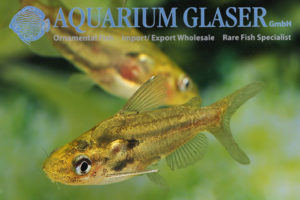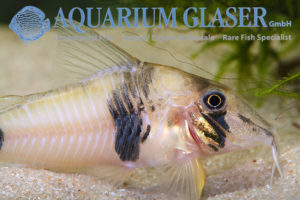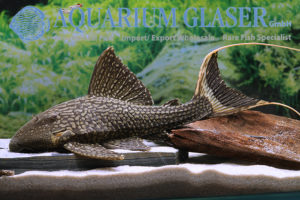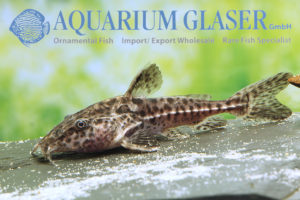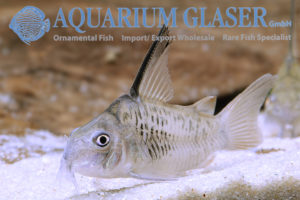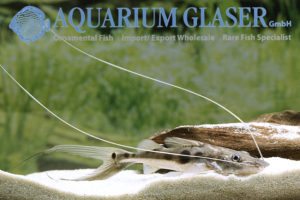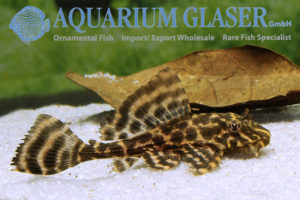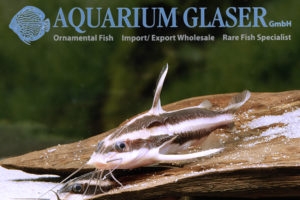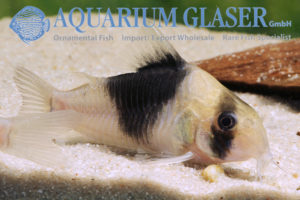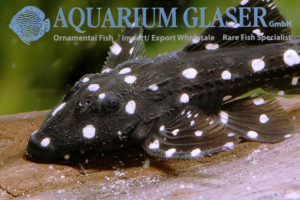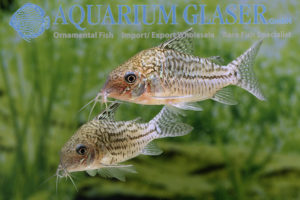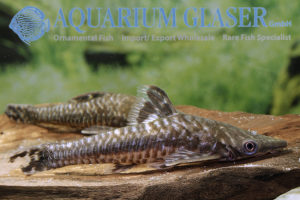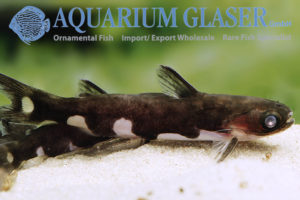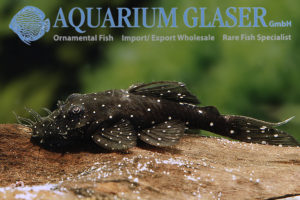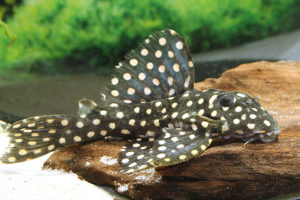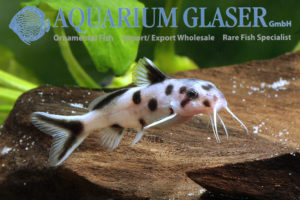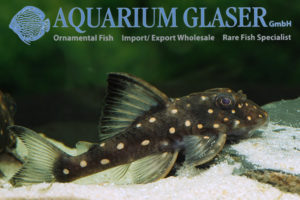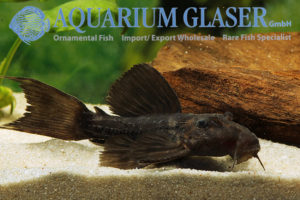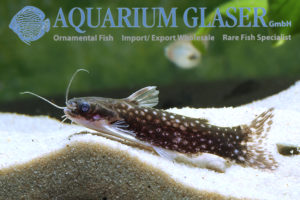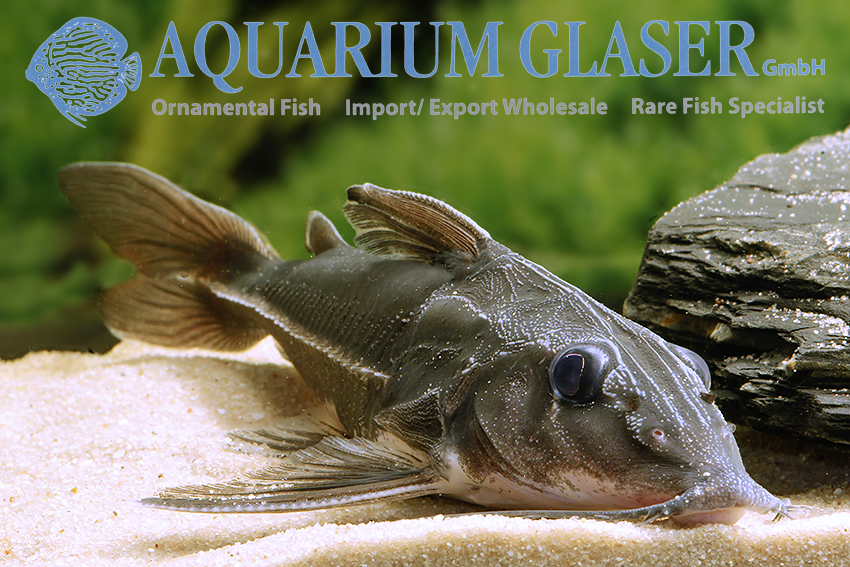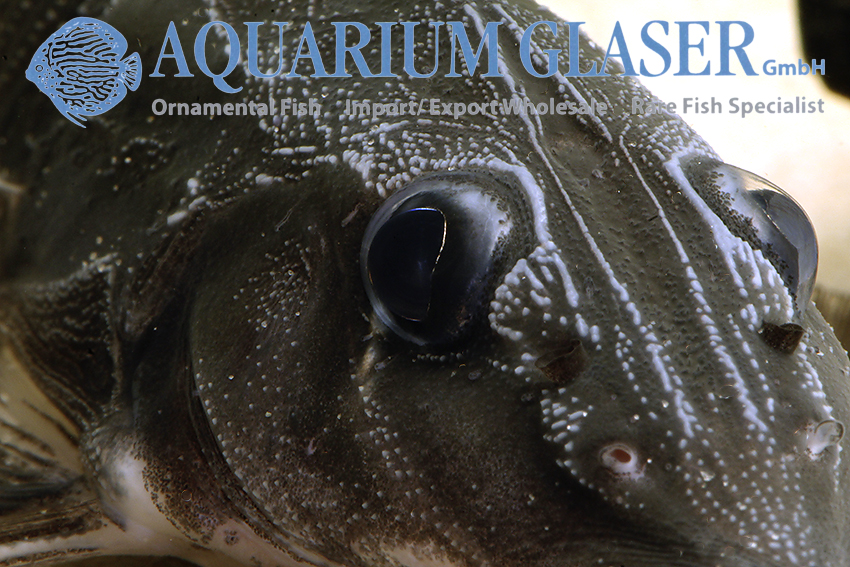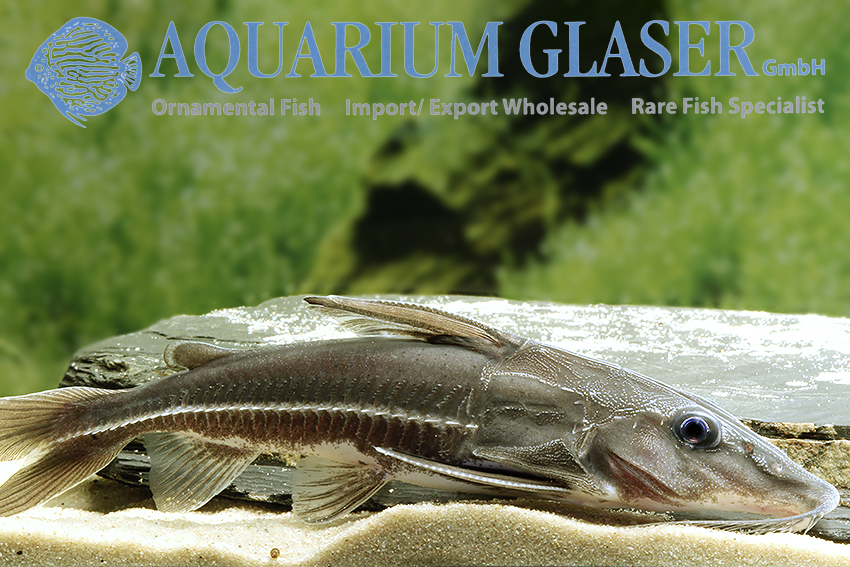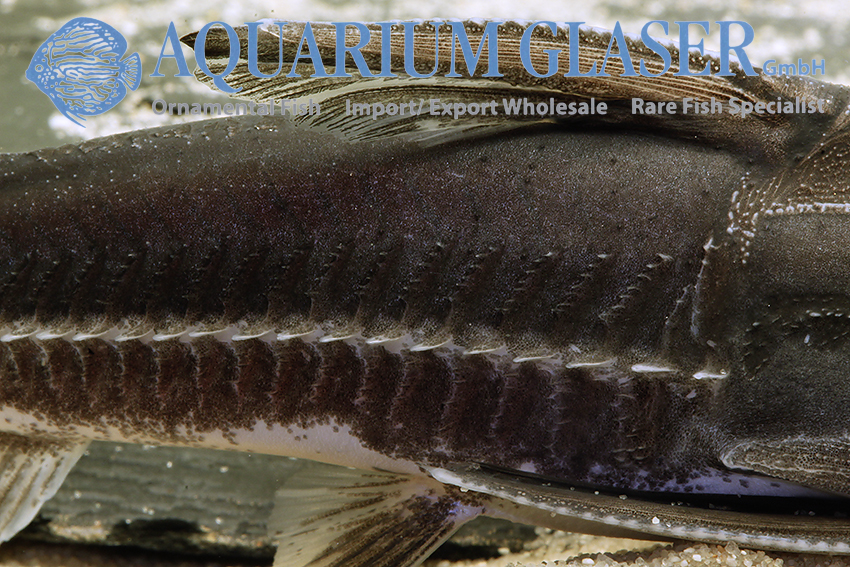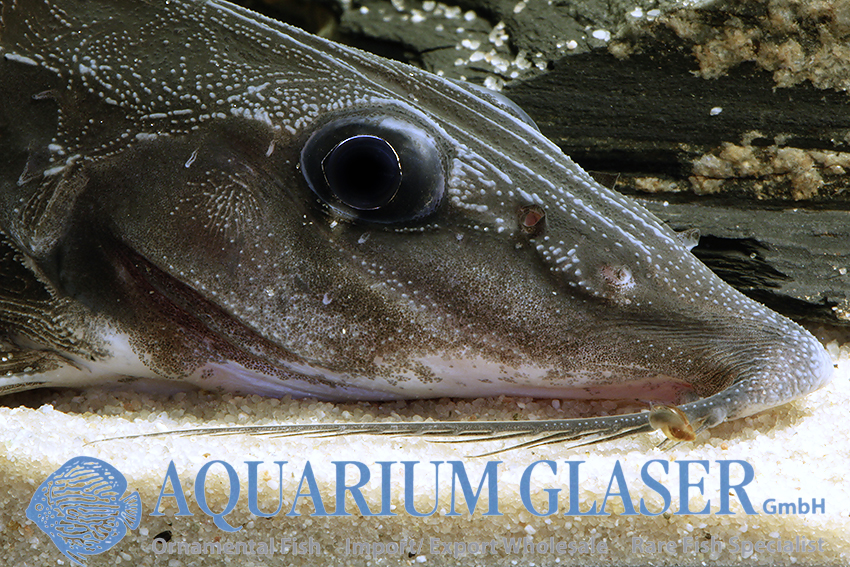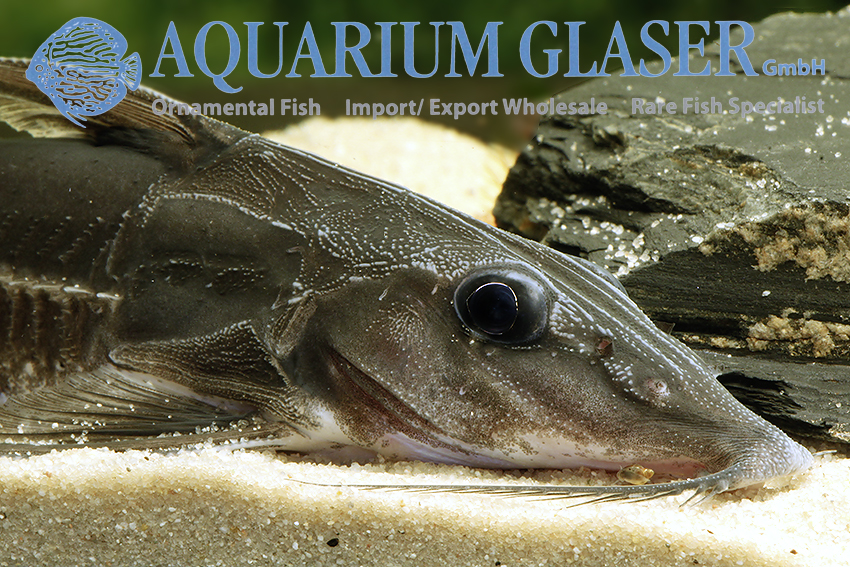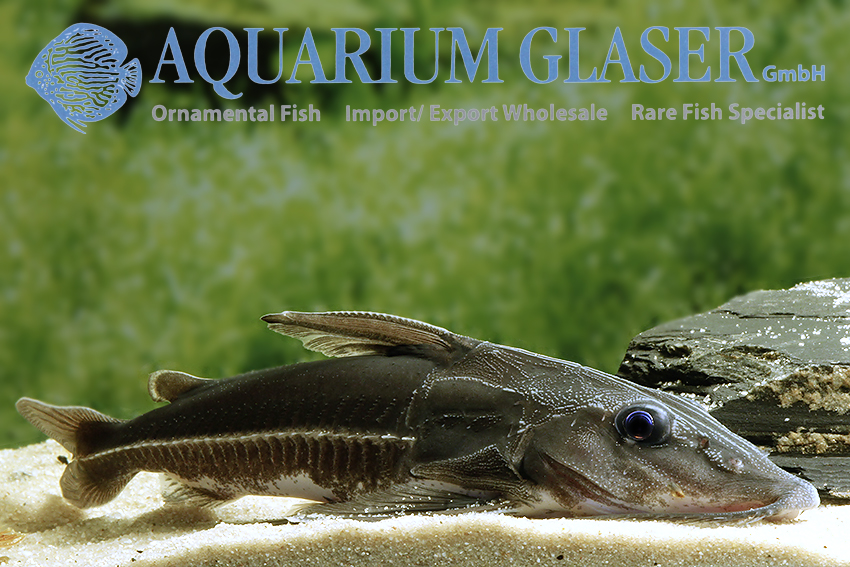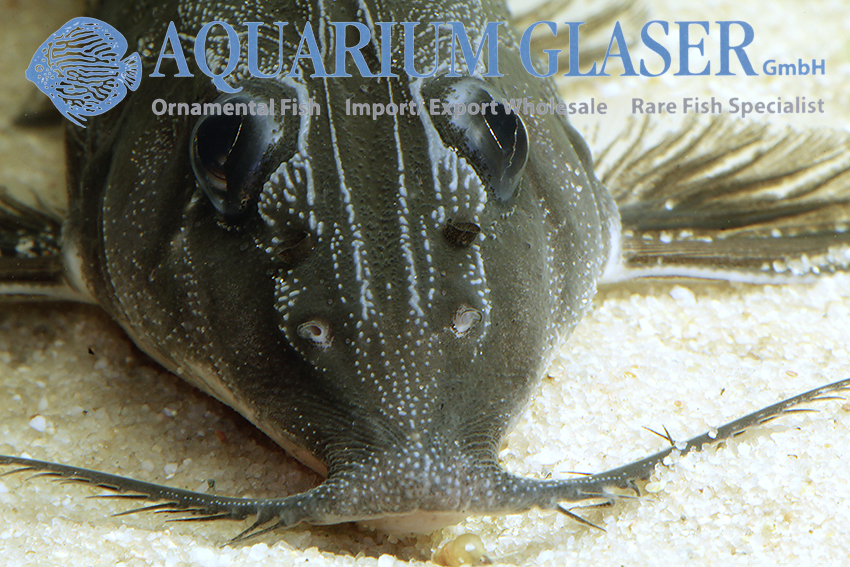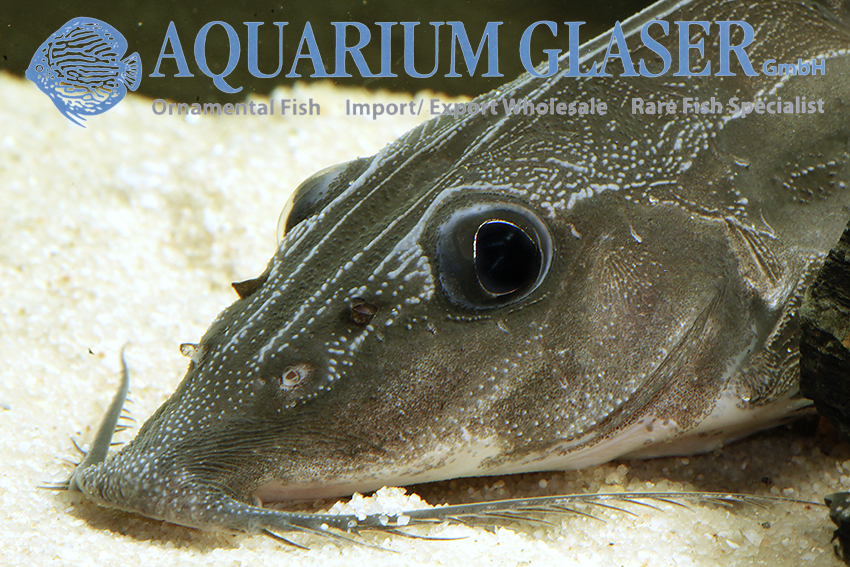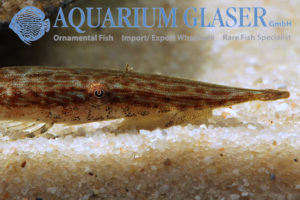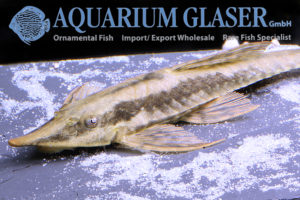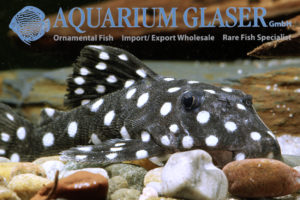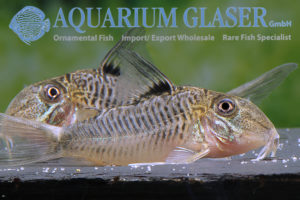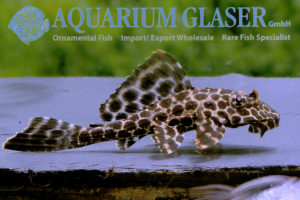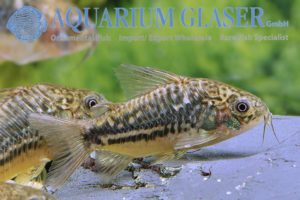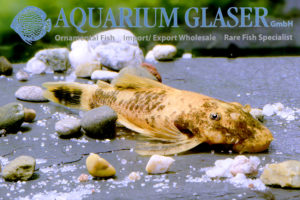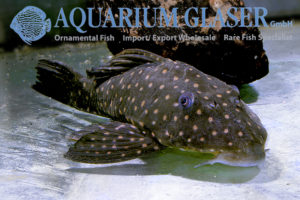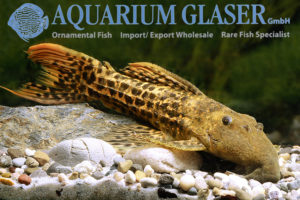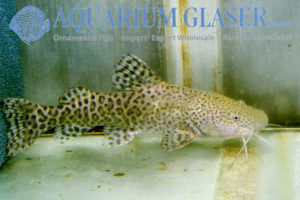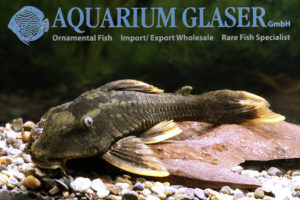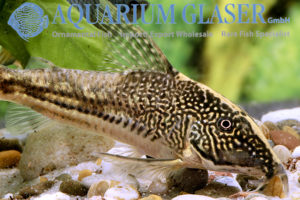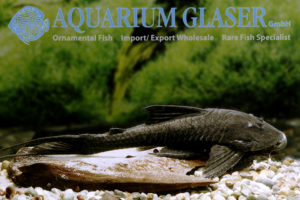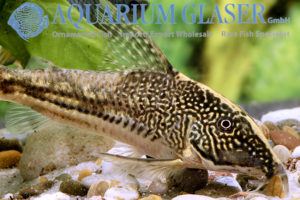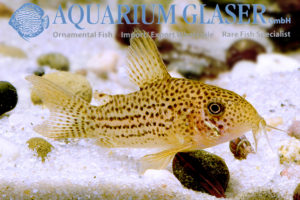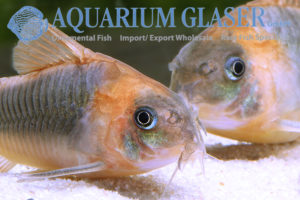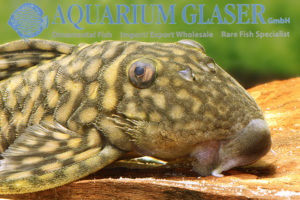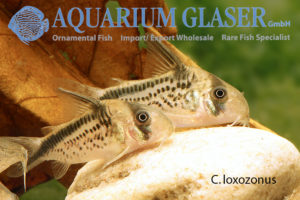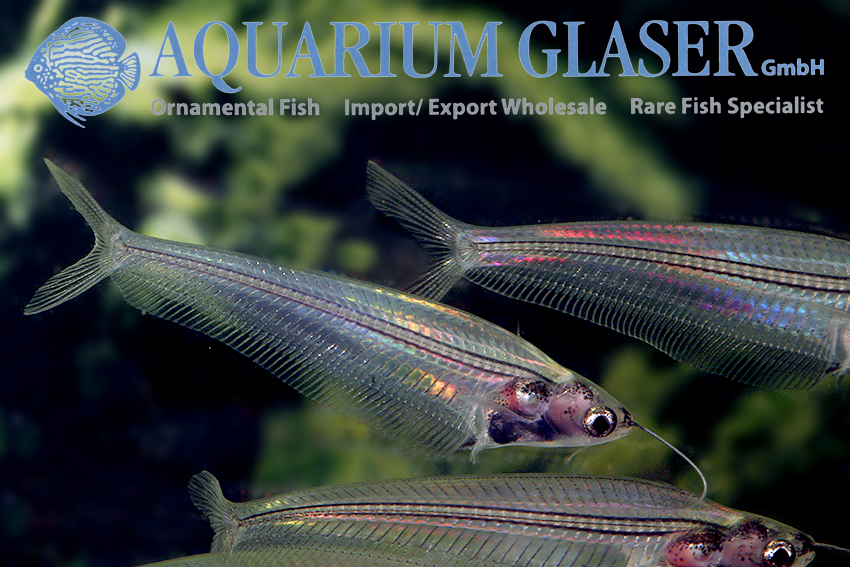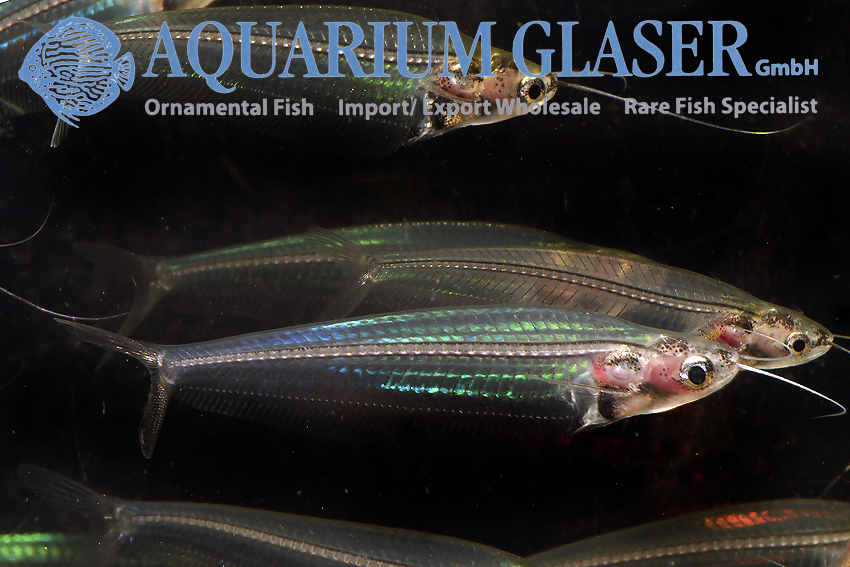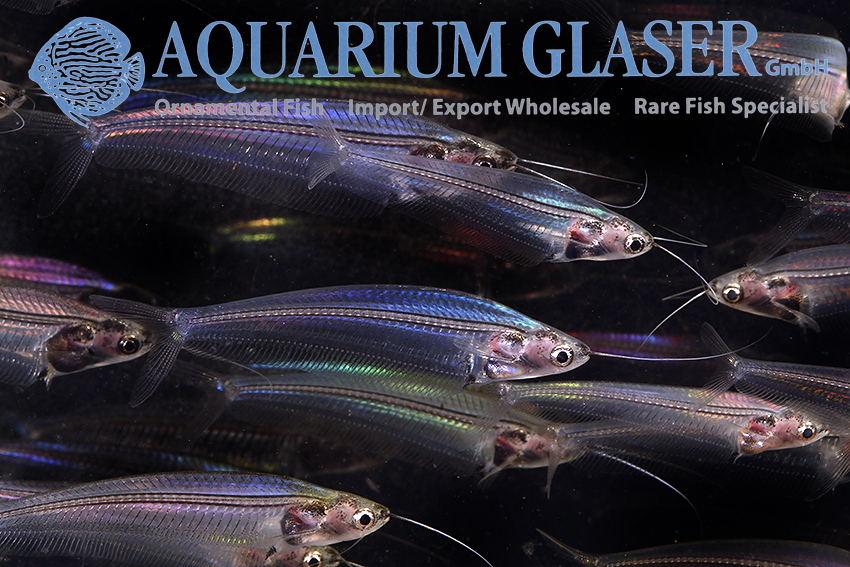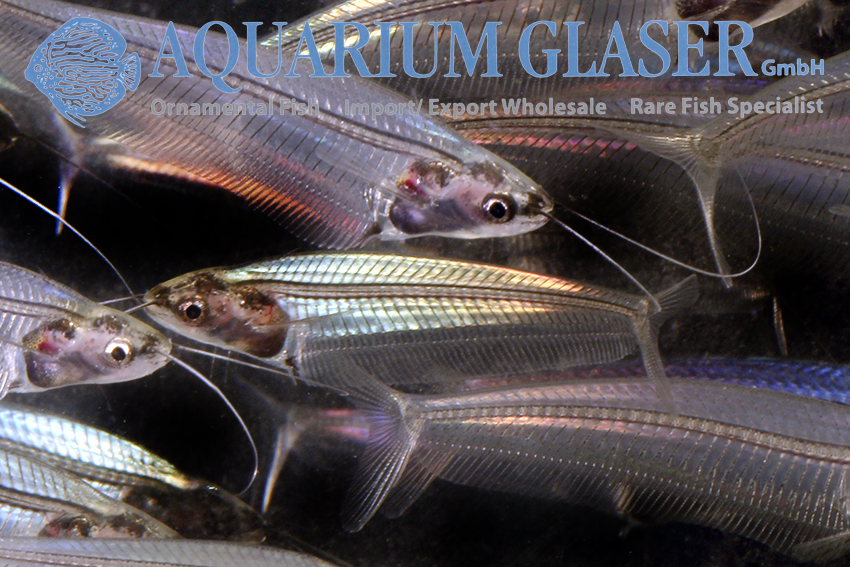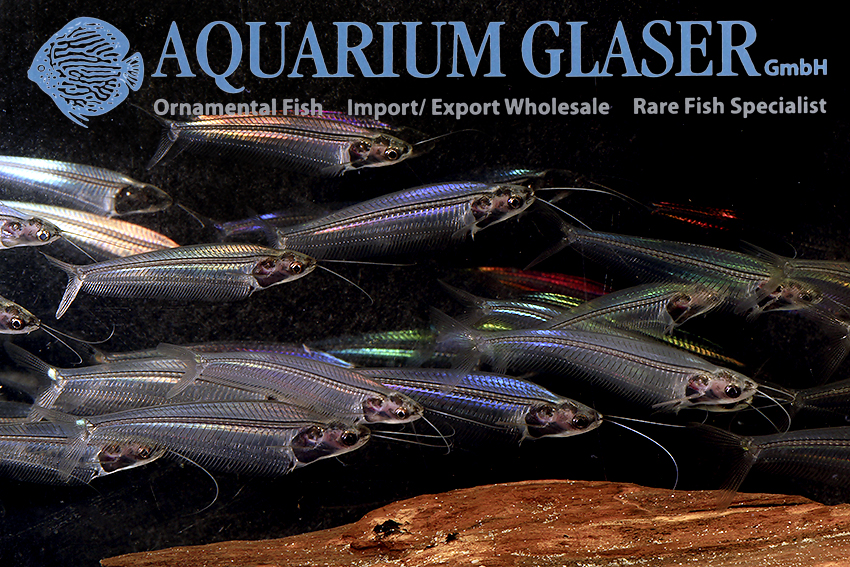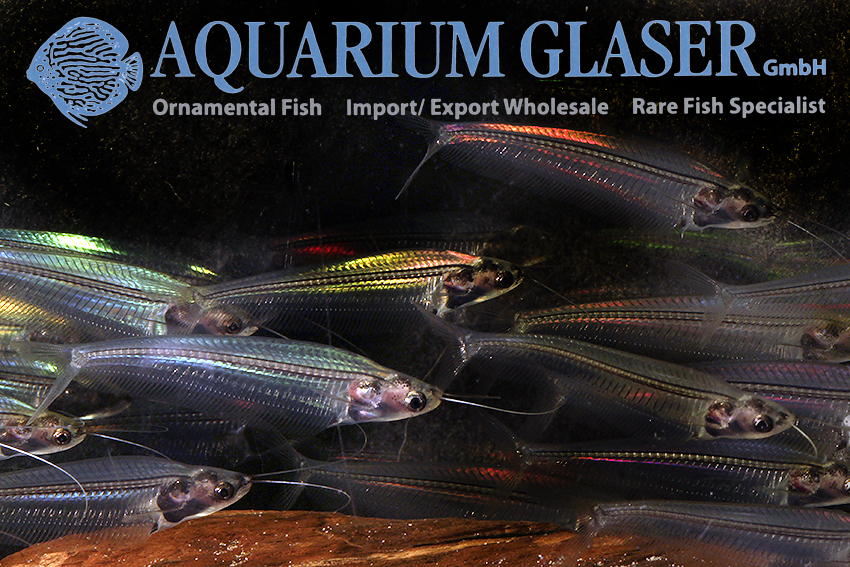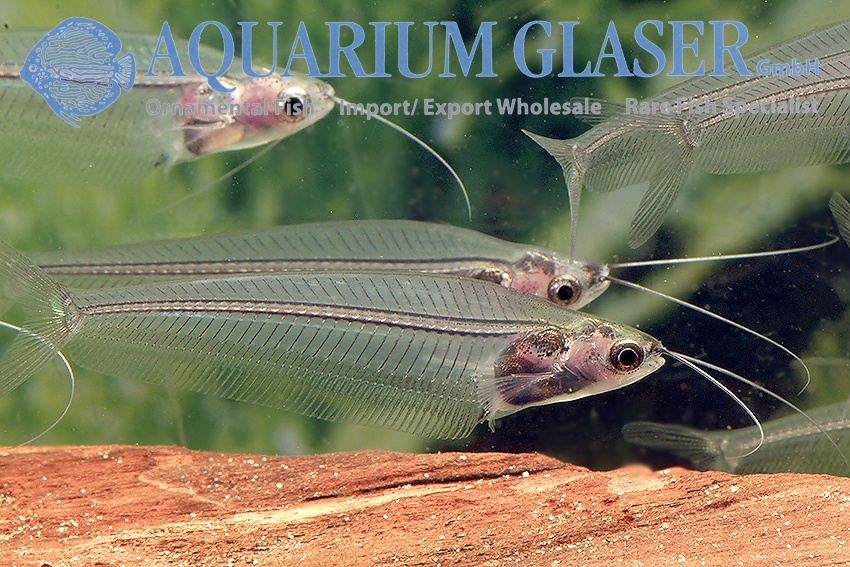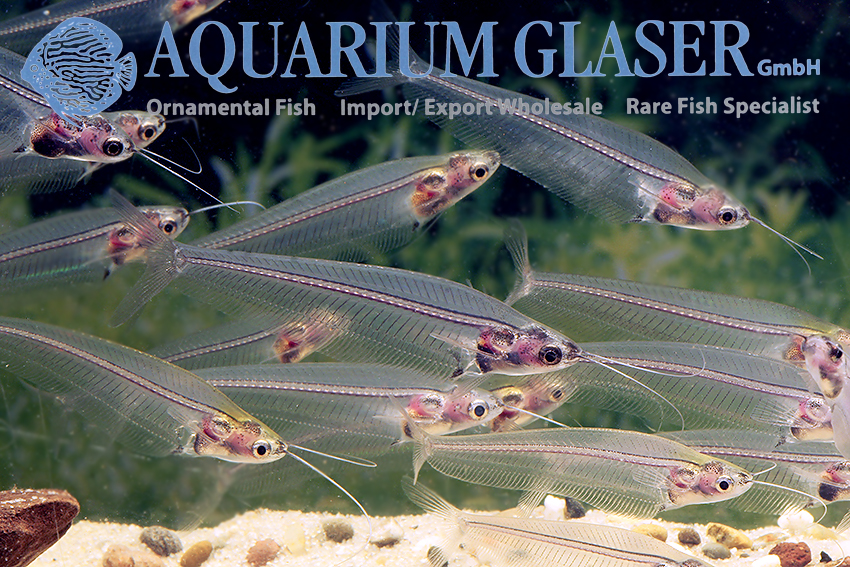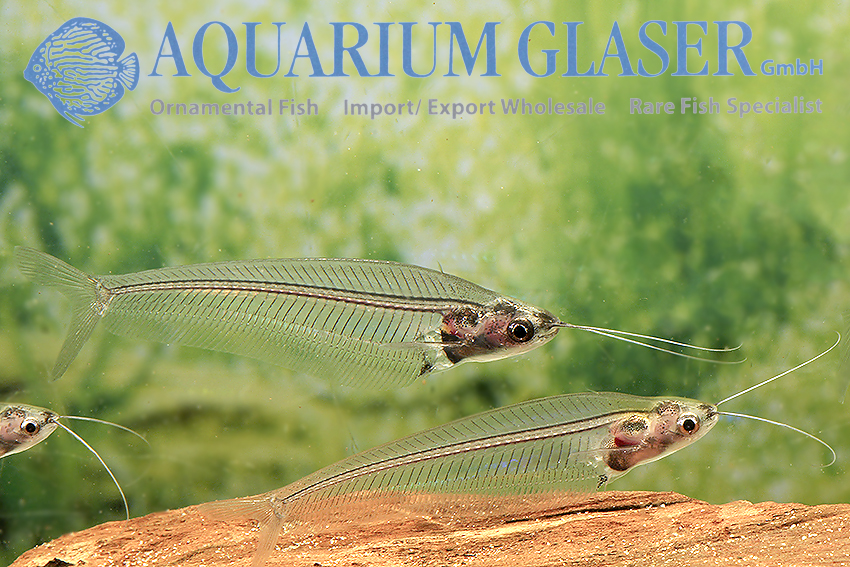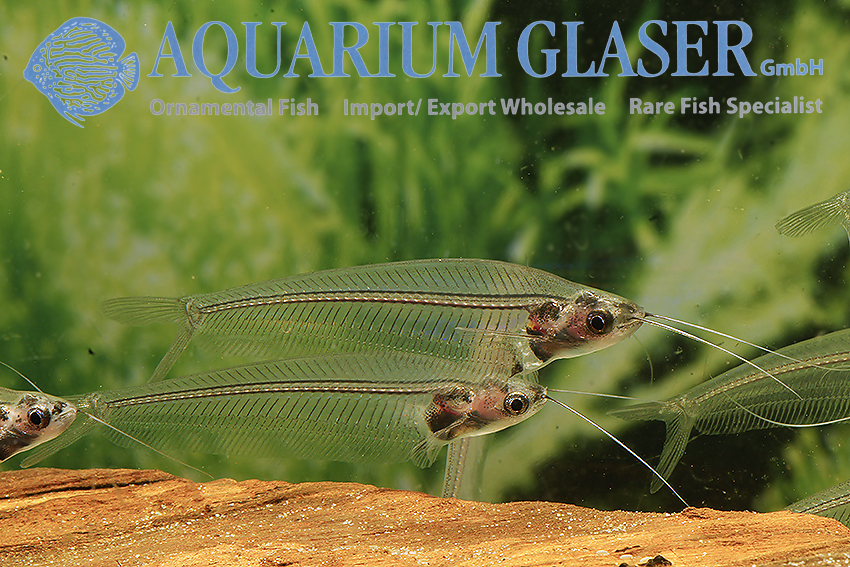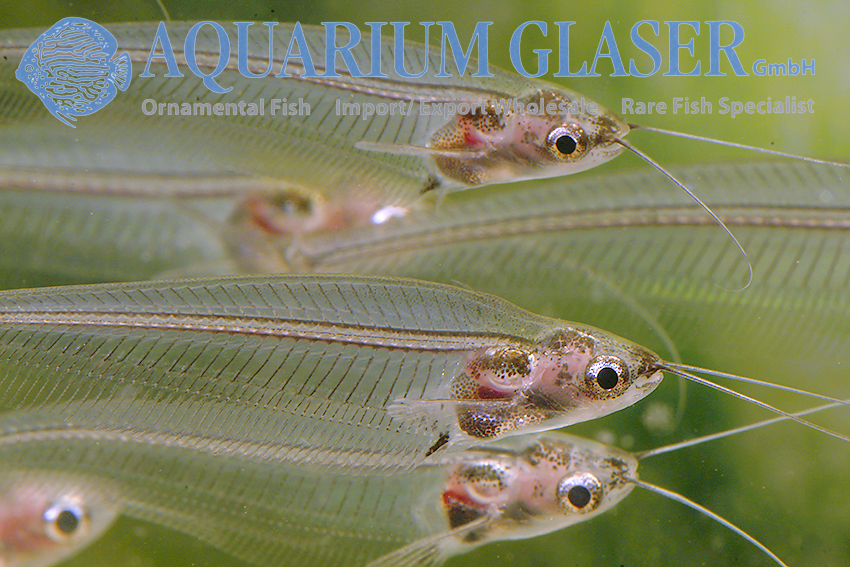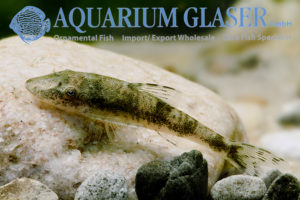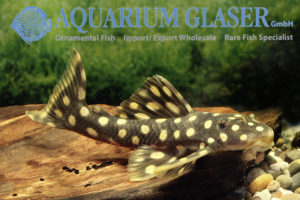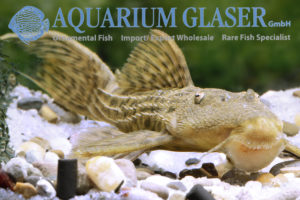The “four-striped Ancistrus” L267 is still a somewhat mysterious species. Even if the first specimen became known already in 1996, this Ancistrus always remained a top rarity in the trade and was not available at all for years. Even the origin remained unknown until now. We get the fish from an exporter in Peru, who […]
10. Catfishes (745)
-
-
Corydoras hastatus
Now is the season for the southern dwarf cory Corydoras hastatus. We get this cute Corydoras, which grows to about 2-3 cm long, from Paraguay. In contrast to most other Corydoras, C. hastatus is less bottom bound. He swims just as gladly in the free water. Often schools of C. hastatus are mixed with several […]
-
Pseudolaguvia muricata
In recent years many highly interesting catfish species ideally suited for aquaristics have been discovered from Asia and imported for aquarists. The first species of the genus Pseudolaguvia were described already in 1927, but only recently it was recognized that this is a very species-rich genus of dwarf catfishes, which usually grow only about 2-3 […]
-
Corydoras sp. aff. aeneus Neon Goldstripe Albino
Albinos occur in all animal species, including humans. Due to a mutation they lack the ability to form black pigments completely or partially. In nature, albinos are extremely rare, because they are too conspicuous and thus quickly become the victim of predators, in human care albinos occur sooner or later in all animal species. Since […]
-
Cetopsorhamdia molinae
For the first time we could import this cute dwarf catfish from Peru. In the scientific literature the maximum size is given as 3,6 cm (without caudal fin). It is absolutely incomprehensible, why this attractively striped fish (however, there are numerous individual colour morphs from banded to almost completely black, some animals are also of […]
-
Pseudolithoxus nicoi
We could import some specimens of the pretty white fringed flying catfish Pseudolithoxus nicoi from Venezuela. This very rarely available species grows to a length of about 12 cm. P. nicoi originates from the Rio Casiquiare, which connects the Rio Negro with the Orinoco. There is great similarity to P. anthrax (L235), which is why […]
-
Loricaria luciae
From Paraguay we received a nice shipment of mouthbrooding whiptail catfishes (Loricaria). Because of the known difficulties to identify species in Loricaria exactly, we first named them provisionally as L. simillima, the aquaristic best known species of the genus, which also occurs in Paraguay. Now that the animals are somewhat acclimated and also the latest […]
-
Lamontichthys filamentosus
From Peru we could import some Lamontichthys filamentosus. This graceful, beautiful species reaches a body length of about 20 cm, the fin filaments can become even that long. Lamontichthys are very sensitive fish, which need optimal water conditions. In addition, the fish are often difficult to bring to the food. Obviously they are very shy […]
-
Batrochoglanis villosus
From the Rio Xingu in Brazil we have received frog catfishes, which are assigned to the species Batrochoglanis villosus. Batrochoglanis was previously placed with Pseudopimelodus. More recent work has divided the frog catfishes into a whole series of genera, which makes it difficult to see through, especially since many species from different genera look darn […]
-
Corydoras sp. CW113
Just as indeterminate sucker catfishes (Loricaridae) receive L and LDA numbers, indeterminate armored catfishes (Corydoras) receive C and CW numbers. The very first C-number assigned was given in 1992 by Werner Seuß to a Corydoras from the upper Rio Negro (Rio Icana). This fish is remarkable in many ways, but the most striking is: there […]
-
Hassar orestis
From Venezuela we could import this pretty and lively thorny catfish. The species is widespread in South America and reaches a length of about 18 cm. In behavior these diurnal catfishes resemble the Corydoras species; however, they are much more active swimmers and constantly on the move in the aquarium. They are peaceful, sociable animals. […]
-
Hemidoras boulengeri
For a long time there were very different ideas among ichthyologists about the generic classification of the thorny catfishes. Aquaristically mainly the genera Doras, Hassar, Hemidoras, Leptodoras, Tenellus and Anduzedoras cause classification problems due to their similar appearance and relatively few useful color characteristics. Fortunately, this has little practical impact because they are all fairly […]
-
Corydoras sp. “punctatus Nanay”
From the Rio Nanay in Peru comes this beautiful spotted armored catfish, which probably belongs to a scientifically undescribed species. It was first mentioned and pictured in aquaristic literature as Corydoras punctatus in the 1930s, but C. punctatus is a completely different species that looks similar to C. julii. Later, the “Nanay” was sometimes assigned […]
-
Pseudeutropius moolenburghae
From Indonesia we received the interesting catfish Pseudeutropius moolenburghae. This shoaling fish, which grows to a maximum length of 10 cm, is very similar in behavior to the well-known glass catfish Kryptopterus vitreolus (formerly known as K. bicirrhis), but is slimmer, livelier and above all has eight long barbels, while the glass catfish has only […]
-
Corydoras treitlii
The long-nosed Corydoras treitlii from the lower Amazon – specimens caught for export mostly come from the Belem area – is one of the real rarities in the trade, although the species is one of the longest known armored catfishes. It was scientifically described already in 1906. With over 7 cm maximum length C. treitlii […]
-
Panaque sp. L191
The large wood-eating Panaque of the relationship around P. nigrolineatus are fantastic fishes. Juveniles are almost splendidly colored, so also L191, a species which is still not described scientifically. L191 originates from Colombia. According to the available information the native area is the Rio Caguán in Caquetá. Particularly splendid is with young L191 the green […]
-
Corydoras sterbai WILD
The splendid Corydoras sterbai probably knows every aquarist child. As one of the most beautiful corydoras at all it belongs to the standard offer of the pet trade and is bred in large quantities; there is also an albino breeding form, which does not occur in the wild. Wild Corydoras sterbai from the Rio Guaporé […]
-
Sturisomatichthys sp. Colombia II
The whiptail catfishes belong to the popular and well breedable loricariids. For example, the Real Royal Farlowella (Sturisomatichthys festivus) has been in continuous breeding for almost 50 years, wild catches of this species are very rare. For other species, wild catches and offspring coexist in the hobby. In former times Sturisomatichthys was considered to mainly […]
-
Soon available: Rineloricaria aurata
From Paraguay we regularly receive shipments of the small whiptail catfishes of the genus Rineloricaria. No less than 65 species are currently recognized, which makes identification in many cases almost impossible without knowledge of the origin. But in the case of Paraguay, there is a recent revision of the species known from this river system […]
-
Pimelodus pictus
Among the large antenna catfishes (Pimelodidae) Pimelodus pictus belongs to the dwarfs. Scientifically proven are 11-12 cm length, but in the aquarium, where these fish can become very old, also 25 cm are said to have occurred. In nature these fishes probably do not live longer than 2-3 years, the keeping record in the aquarium […]
-
Parotocinclus bahiensis and P. cearensis
The genus Parotocinclus currently exists in a kind of shadowy existence in aquaristics. In contrast to their cousins of the genus Otocinclus, hardly anyone knows these equally small loricariids, which are, however, equally zealous algae exterminators. We have received from the Northeast region (Região Nordeste), more precisely from the states of Cereá and Bahia of […]
-
Corydoras kanei
This pretty, at most 5 cm long corydoras wandered for many years under different names through the aquariums, until it was finally described in 1997 by Steven Grant as an independent species: Corydoras kanei. Unfortunately the description is flawed by the fact that the type specimens came from the trade and therefore the type locality […]
-
Corydoras “punctatus” Nanay
There is a saying: “The Internet forgets nothing”. This may be true, but books are even more durable, especially if errors have been printed in them. These are often so stubborn that one could almost despair. This is what happened to a very pretty armored catfish that occurs in huge numbers in the tri-border area […]
-
Tetranematichthys wallacei
At present three species of the strange genus Tetranematichthys are distinguished. None of them comes more frequently or even regularly into the trade, because their hidden way of life makes their catch a pure matter of luck. So we were particularly pleased to be able to import the species T. wallacei from Colombia. We are […]
-
Ancistrus sp. Bushmouth LDA 72
Ancistrus species belonged to aquaristics long before one even thought of the term L or LDA number. Unfortunately, the systematics of the group is complex, there have been and still are misidentifications and – this is especially unfortunate – the species can apparently often be crossed, so that aquarium hybrids have been created unintentionally. Such […]
-
Corydoras sodalis (incorrect as agassizii).
There are four species of beautiful corydoras, which are practically without exception available as wild collected specimens from Brazil, because even experienced breeders have a hard time with them. In addition, these species occur in masses and can therefore be offered in large numbers and very cheaply, so there is little incentive to breed them. […]
-
Astroblepus from Colombia
The L-catfishes or Loricariidae from South America belong to the most popular and most desired catfishes for the aquarium. However, even experienced aquarists have hardly ever had the opportunity to see a living representative of the genus Astroblepus. It is the only genus of the family Astroblepidae, the closest relatives of the Loricariidae, distinguished from […]
-
Aspidoras raimundi “Ceará”
The representatives of the genus Aspidoras are popularly also called loach armored catfishes, which is quite a good description. Because the animals are slimmer and more scurrying, than one is generally used to from Corydoras. With 25 species recognized so far, the genus is quite species rich. Their identification is difficult for non-specialists, because species […]
-
Pseudacanthicus sp. L600
We have received fantastic leopard cactus plecos L600. They are german bred ones. One specimen is as beautiful and flawless as the other! We are extremely enthusiastic about the quality of the animals. They are currently 6-8 cm long. For our customers: the fish have code 26480-L 600-2 on our stocklist. Please note that we […]
-
Parancistrus sp. Rio Araguaia L56n / LDA46
The genus Parancistrus includes only two scientifically accepted species, the Golden Parancistrus (P. aurantiacus), which was erroneously also assigned L-number 56 (this is incorrect) and P. nudiventris, which was assigned L-numbers 31 and 176; this is a black catfish with very fine white spots. In addition, we know L258 from Rio Iriri, a black catfish […]
-
Hypostomus sertanejo
For the first time we can offer this very nice Hypostomus from the Rio Jaguaribe (Cerea State, Brazil). It is a species that was described scientifically only in 2017, although 19 specimens of this species were found in the scientific collection of the Academy of Natural Sciences of Philadelphia, U.S.A., which had been collected and […]
-
Corydoras cf. brevirostris CW 27 Highfin
We received a limited number of this extraordinary Corydoras from Colombia. The overall appearance is very much alike Corydoras brevirostris (formerly known as Corydoras melanistius brevirostris), but CW 27 has a much much higher dorsal fin and the “glowspot” on the nape is much brighter. For our customers: the animals have code 224954 on our […]
-
Physopyxis lyra
Although this dwarf among the thorny catfishes – it only grows to about 3 cm in length – was scientifically described as early as 1872, it was completely unknown to aquarists until a few years ago. This is a pity, because they are droll, very interesting small catfishes, which are also suitable for small and […]
-
Rineloricaria teffeana
The small remaining whiptail catfishes of the genus Rineloricaria enjoy great popularity among aquarists. They have a whimsical appearance, are peaceful, have no high space requirements and can usually be bred quite well. Some species have even really fancy pattern. The most beautiful is certainly R. teffeana. It has no bright colors, but a really […]
-
Parotocinclus jumbo LDA25, now available as German bred!
The cute Parotocinclus jumbo, also known as Pitbull Pleco or LDA25, is a very popular aquarium fish. Unfortunately imports take place only very irregularly and can hardly be planned. Therefore we are happy to be able to offer this nice little fish as offspring now. More information about the species can be found here: https://www.aquariumglaser.de/en/fish-archives/lda25-parotocinclus-jumbo-2/ […]
-
Hara hara/Erethistes pusillus
In India live two species of moth catfishes, which are practically impossible to distinguish in living condition. They are nevertheless sometimes even assigned to two different genera: Hara and Erethistes. The difference between the two genera lies in the structure of the vertebral body, that is, of something invisible in the living animal; according to […]
-
Corydoras leucomelas
Corydoras leucomelas belongs to the frequently imported species of its genus. Typical characteristics of the round-nosed species are a strongly pronounced eye band, the coloration of the dorsal fin in connection with the black dorsal spot located at the beginning of the dorsal fin, a vertical black band at the end of the caudal peduncle […]
-
Hoplomyzon sexpapilostoma
Within the banjo catfish family (Aspredinidae), there is a group of dwarfish small species (called the tribus Hoplomyzontini) divided into four genera: Ernstichthys, Hoplomyzon, Dupouyichthys and Micromyzon. They grow only 2-3 cm long. In nature they live buried in fine sand (at least during the day). Most species prefer the deepest channels of medium to […]
-
Bagrichthys macracanthus
Bagrichthys macracanthus is a very interesting catfish from Southeast Asia (East Sumatra). This catfish reaches a maximum length of about 20 cm. In nature it lives in calm river sections. Among themselves, especially the males are quite incompatible, in pairs or in groups of a male with a surplus of females maintained, however, the species […]
-
Tatia intermedia
From Peru a larger number of Tatia reached us thanks to this import we can now solve an more than 10 year old puzzle. In 2011 we received from this country monochrome Tatia, which could not be assigned to any known species (https://www.aquariumglaser.de/en/fish-archives/tatia_sp_tahuayo_river_en/). Now it is clear: it is a monochrome color variant of T. […]
-
Corydoras loxozonus
This Corydoras belongs to the most attractive and at the same time easy to keep species of the large genus Corydoras. One should only consider that C. loxozonus – it originates from the Orinoco and its tributaries – likes it warm; below 24°C the temperature of the water should not sink in the long run. […]
-
Corydoras narcissus and Corydoras bethanea (= C. sp. “Narcissus II”; CW6)
The changed export regulations in Brazil, which have been valid for some time, have now made it possible to import Corydoras narcissus again after a long time. Corydoras narcissus is a beautiful, relatively large armored catfish. The maximum length is given with 10 cm. The species comes from Brazil, more precisely from the drainage of […]
-
Chandramara chandramara
In 1822, the most comprehensive book on the fish life of the Ganges River in India to date was published. The author was the Scottish physician Francis Hamilton, who was in the service of the East Indian Company. Hamilton had detailed drawings made of all the fish species he found in the Ganges. His draftsman […]
-
Corydoras desana
There are still Corydoras species which are imported so rarely and in such small numbers that they belong to the unfulfilled dreams of armored catfish lovers. One of the most attractive species of this group is certainly the “Tukano Longnose”, as it was first named, then it received the code CW011 and finally the species […]
-
L90a Panaque bathyphilus
The large-growing, magnificent Panaque bathyphilus is very variable in coloration. We have at present quite splendid 16-20 cm long animals in stock. With this they are about half grown, as maximum length for P. bathyphilus about 60 cm are given. It goes without saying that these large fish should only be kept in large aquariums. […]
-
Oxydoras niger
With a maximum length of 1 meter Oxydoras niger belongs to the largest species of thorny catfishes. Nevertheless it is a very peaceful species and therefore quite attractive for owners of very large aquariums, show aquariums and zoos. Fully grown these fishes are uniformly black (this is exactly what the species name “niger” = black […]
-
Corydoras armatus
In the last years we reported more often about Corydoras imports, which are similar to Corydoras armatus (= sp. aff. armatus or cf. armatus), but not identical. Now we received again the “real” C. armatus from Peru. The enormously high dorsal fin is really an eye-catcher. In addition it is always carried tautly upright, which […]
-
Platysilurus mucosus
Predatory catfishes exude a special fascination to many a catfish lover. Unfortunately, many species simply become too large for permanent care in a normal sized home aquarium. However, there are also species that grow to only 20-30 cm in length and for which it is therefore not necessary to flood the entire basement to meet […]
-
Glyptoperichthys parnaibae
For the first time ever we can offer Glyptoperichthys parnaibae, so far known exclusively from the Rio Parnaiba in Brazil. The Rio Parnaiba is located in the northeast of Brazil and has a high proportion of endemic, i.e. only there occurring fish species, because there is no connection to other river systems. The juveniles of […]
-
Platydoras armatulus
The snarling zebra catfish – this is how Platydoras armatulus could be popularly called. However, it is actually called the striped raphael catfish. All spiny catfish can make distinct growling or croaking sounds when taken out of the water. They vibrate their whole body. Presumably this serves as a defense against enemies. But even without […]
-
Corydoras sp. CW 51
The “New Pandas” from Colombia belong to the most attractive and at the same time easy to keep and breed corydoras of the last years. There are two forms/species, CW 49 and CW 51, which differ clearly in the shape of the black saddle spot. For CW 49 please see here: https://www.facebook.com/page/119893808211837/search/?q=cw49, for origin etc. […]
-
L129 var Hypancistrus debilittera
The small remaining, nicely marked Hypancistrus debilittera from the Rio Bita (a tributary to the Rio Meta, Colombia, Orinoco drainage) enjoys a great popularity since years. Already with 7 cm length the males become sexually active, the maximum length is given with about 12 cm. We import this species regularly. Recently we received a “Hypancistrus […]
-
Acanthicus adonis
Now it is season again for one of the most beautiful of all loricariid catfishes: Acanthicus adonis. The species name “adonis”, which is reminiscent of the ancient god of beauty and vegetation, Adonis, is aptly chosen. For like the god described as a beautiful youth, the Adonis catfish is such a beauty only when young. […]
-
Ameiurus melas
Among the aquarium fishes that have been kept already in the 1890ies belong the two species of bullhead catfish Ameiurus melas and A. nebulosus. Both species are very similar to each other and even specialists have problems to tell them apart. Initially bullhead catfish were brought to Europe as foodfish in the 1880ies from the […]
-
Corydoras sodalis Colombia
Widespread species often show coloration differences in the different parts of the distribution area. So also the beautiful Corydoras sodalis, which is reported from Peru, Brazil and Colombia. From Colombia we could now import C. sodalis, which differ quite clearly in color and figure from e.g. animals imported from Brazil (see https://www.aquariumglaser.de/en/fish-archives/corydoras-sodalis-2/). For our customers: […]
-
Rhinelepis cf. strigosa
The two species of the genus Rhinelepis – R. aspera and R. strigosa – belong with over 60 cm attainable final size to the largest armored catfishes at all and are therefore predestined as show objects in zoos, public aquariums and of course also for owners of gigantic private aquariums. Color-wise they have nothing to […]
-
Corydoras robustus
This Corydoras belongs with 9-11 cm of total-length to the biggest and most splendid species of the genus at all. Both sexes develop, when they are sexually active, long dorsal fins. The males can be recognized by the additional long ventral fins. At the moment we have wonderful, fully grown, well settled animals in stock. […]
-
L92/L194 Lasiancistrus tentaculatus
There seems to be a consensus among armored catfish enthusiasts that L92, which is very widespread in the Orinoco drainage of Colombia and Venezuela and later received another L-number, namely L194, is identical to Lasiancistrus tentaculatus, which was described in 2005. However, L. tentaculatus is described as more or less monochromatic brown, while L92 is […]
-
Hypoptopoma sp. Ucayali
From Peru we could import very nice Hypoptopoma. Most of the import consisted of H. gulare (see https://www.aquariumglaser.de/fischarchiv/hypoptopoma-gulare/), but there were some specimens with very conspicuous, broad bands in the dorsal fin and contrasting caudal fins. Unfortunately the identification attempt based on the current revision of the genus (Aquino & Schaefer, 2010) did not give […]
-
Batrochoglanis sp. Venezuela
Something is happening with the South American bumblebee and frog catfishes! In former times they were assigned to the long-whiskered catfishes (Pimelodidae), today they are placed in an own family, the Pseudopimelodidae. Often in the trade are the striking yellow-black marked, only 3-8 cm large South American bumblebee catfishes (Microglanis, 23 species), and the similarly […]
-
Corydoras sp. “Ogawae” CW86 (cf. armatus)
Corydoras armatus is a rather distinctive cory from Peru. We have also received this beautiful species, which is notable for its particularly high dorsal fin, from Venezuela from time to time (see https://www.aquariumglaser.de/fischarchiv/corydoras_armatus_venezuela_de/). Geographically this all fits together well, the catching regions both belong to the upper drainage of the Amazon. However, there is a […]
-
Tatia musaica/ Centromochlus musaicus
When the first black and white “Tatia” appeared in the ornamental fish trade some years ago, they were celebrated as a sensation. (see https://www.aquariumglaser.de/en/fish-archives/centromochlus_sp_ninja_en/ and https://www.aquariumglaser.de/en/fish-archives/tatia_musaica_en/). We identified these fish, which originated in Brazil, as Tatia musaica. In 2017, a team of scientists published a study on Centromochlus species and described the species previously known […]
-
Ancistrus sp. L184 (= L107)
One of the most attractive Ancistrus species is this so far not scientifically identified species from the middle Rio Negro in Brazil. There the beautiful fish is not rare, in some places even very common, but the species apparently prefers biotopes which are avoided by the local fishermen; otherwise it can hardly be explained why […]
-
Rineloricaria lanceolata “Red Dun“
For the first time we can offer the breeding form “Red Dun” of the Chocolate Whiptail Catfish. This new breeding form goes back to a wild-caught male that we were able to import from Paraguay in November 2015 (see https://www.aquariumglaser.de/en/fish-archives/rineloricaria_lanceolata_en/). We gave it, together with some normal females of the same import, to our breeder […]
-
Hypancistrus contradens L201a Big Spots
From the lower Rio Ventuari in Venezuela – the largest tributary of the Orinoco – as well as from the Orinoco itself in the Ventuari estuary comes a beautiful Hypancistrus. It has large, bright spots on a deep black ground. The coloration of the spots is varying between shy white and orange-pink. There is a […]
-
Synodontis polli “White”
Some time ago a small Synodontis appeared in the hobby, which is called “White Polli”. But the “White” has little in common with the actual Synodontis polli. The dorsal fin spine of “White” is bicolor, black in the lower half, white in the upper half. This species is distributed in the hobby almost exclusively as […]
-
L501 Hypanacistrus sp. Mitu
Snowball plecos belong to the largest Hypancistrus species. They can reach up to 20 cm in length. Members of the group are easily recognized by the conspicuous black fringes in the dorsal and caudal fins. Distinguishing the aquaristically known form, on the other hand, is tricky and sometimes simply impossible without knowledge of the origin. […]
-
Pseudacanthicus sp. L185 Bred
The cactus plecos (Pseudacanthicus) are popular with owners of large aquariums. L185 originates from the Rio Xingu and is also called Belo Monte Cactus Pleco, because this catfish used to be caught there. We do not know if the species still exists there, or if it was wiped out by the construction of the Belo […]
-
Tatia galaxias
The cute Tatia catfishes are quite popular in the hobby. Keepers put up with the fact that you can hardly see them outside feeding times, because they are extremely addicted to hiding. But they make up for it with their pretty coloration and good breedability. Tatia galaxias comes from the Orinoco river basin in Colombia […]
-
Akysis prashadi
The range of small, peaceful catfishes from Asia is much smaller than from South America, but they do exist. Moth catfishes (Hara, Erethistes) for low flow aquariums and wasp catfishes (Akysis) for tanks with more flow are becoming increasingly popular. Akysis get their name “wasp catfish” from the most famous species, Akysis vespa, whose sting […]
-
Acestridium dichromum
The strange sucking catfishes of the genus Acestridium – there are currently seven recognized species in the genus – could also be called “dwarf needle catfishes”, because they look like a miniature version of the needle catfishes of the genus Farlowella. Unfortunately, these animals are still an aquaristic challenge, which only very experienced aquarists should […]
-
The sturgeon catfishes of Paraguay: Sturisoma barbatum or S. robustum?
From Paraguay wonderful, partly very large sturgeon catfishes (Sturisoma) are imported. Two Sturisoma species are known from the Rio Paraguay: S. barbatum, described already in 1853 by Kner, and S. robustum, described in 1904 by Regan. The two species differ from each other only insignificantly. The most important anatomical feature distinguishing the two species is […]
-
Baryancistrus sp. Snowflake LDA 33 / L142
This beautiful loricariid catfish comes from the Rio Tapajós in Brazil. Usually, 4-5 cm long youngsters are imported from these catfishes, which look very attractive with their large, white dots on a deep black ground and fully deserve the name “Snowball-Pleco”. In addition to high water temperatures (not below 28°C), these catfishes should be kept […]
-
The “real” Corydoras melini?
One of the most important arguments for importing wild-caught fish for aquaristics is the gain in knowledge it allows. For the majority of small fish species this is only possible by observing living specimens. Without this there is no species knowledge, without species knowledge there is no species conservation. A wonderful example of the above […]
-
Corydoras geoffroy
For a long time this fish, the type species of the genus Corydoras, was a mystery. Until today it is a top rarity among the armored catfishes. And so we are especially pleased to be able to offer offspring of this precious fish once again. The animals are still a bit inconspicuous, so we would […]
-
Glyptoperichthys gibbiceps
The red highfin sucker is a classic, which found its lovers long before the invention of the L-numbers. Juveniles are really adorable and excellent algae killers. In addition they look very beautiful. Since this catfish easily grows to 30-40 cm in length, there are two camps among aquarists. Some are critical of the animal because […]
-
Corydoras undulatus Paraguay
The beautiful Corydoras undulatus belongs to the relationship of C. elegans. Like most representatives of this group the species swims rather in free water than on the ground. Also typical for the group is that males and females differ clearly in color. In the case of C. undulatus the males become very dark with bright […]
-
Rineloricaria parva
From Paraguay we regularly receive shipments of the small whiptail catfishes of the genus Rineloricaria. No less than 65 species are currently recognized, which makes identification in many cases almost impossible without knowledge of their origin. But in the case of Paraguay, there is a recent revision of the species known from this river system […]
-
Ancistrus Orange Brown “LDA16”
This extremely attractive Ancistrus is a breeding form. The actual LDA 16 is a wild form imported in 1994 from Brazil (Rio Puraqequara, a tributary of the Rio Guamá, which in turn is a tributary of the Rio Tocantins) and is uniformly purple-brown in color. We do not know if the orange-blotched Ancistrus descended from […]
-
Hypostomus roseopunctatus L311
Not less than 148 species are counted to the genus Hypostomus, but no five of them appear more often in the trade. Special is of course H. luteus with its sail-like dorsal fin and the bright yellow coloration, but most species are “plecos”, brown or gray with black spots. In addition, most species grow quite […]
-
Pseudacanthicus sp. L273 Titanic
The magnificent cactus catfish L273 Titanic, up to 30 cm long, originates from the Rio Tapajós. Its first import in 1998 was a sensation. Interesting about the animals, which are allowed to be exported from Brazil again since some time, is the very individual body pattern. All cactus catfishes are carnivores; towards non-species fishes they […]
-
Zungaro zungaro
The catfish Zungaro zungaro belongs to the largest catfish species of South America. There were all kinds of debates about its name, for a long time it sailed under Pseudopimelodus zungaro or Paulicea luetkeni. Because of its gigantic size (length up to 140 cm, weight up to 50 kg) the species is difficult to study […]
-
Cochliodon sp. L360
We have received some beautifully marked yellowseam catfish. This catfish originates from the middle Rio Jamanxin in Brazil and has not yet been correctly (i.e. scientifically) identified, neither in terms of genus nor in terms of species. However, it is quite possible that this catfish has already been scientifically described; young animals are quite inconspicuous, […]
-
Scleromystax barbatus
The changed legal situation in Brazil now makes the import of several species from the south of Brazil possible again, which for many years were only available as offspring, among them the magnificent Scleromystax barbatus (formerly Corydoras b.). We have been able to import a good number of wonderful, fully grown specimens. For more information […]
-
L350 Panaque sp. Black Lyretail
From Peru we received four specimens of a top rarity: L350. This peculiar fish does not fit any genus of loricariid catfish known to date. It originates from deep, turbid, very fast flowing water of the Peruvian Amazon, where it can only be caught with great difficulty and rarely. It is a carnivorous species whose […]
-
Scleromystax barbatus
The changed legal situation in Brazil now makes the import of several species from the south of Brazil possible again, which for many years were only available as offspring, among them the magnificent Scleromystax barbatus (formerly Corydoras b.). We have been able to import a good number of wonderful, fully grown specimens. For more information […]
-
Corydoras eversi (C65)
The very nice Corydoras eversi lives in the Araguaia drainage (Brazil) and became known as C 65. It was only scientifically described in 2016. The scientific treatment of C. eversi is based on a collection by Hans-Georg Evers in 1998, who was also able to bring living animals with him. As mentioned, they were initially […]
-
Coryoras eques
From the Brazilian state of Amazonas, more precisely from the surroundings of the city of Anori, we once again received a good number of a beautiful armored catfish, which is known to science for a long time, but rarely appears aquaristically: Corydoras eques. This typical schooling Corydoras looks most attractive when kept in black water. […]
-
Spectracanthicus (= Oligancistrus) zuanoni L 354
Spectracanthicus zuanoni L 354 originates from Rio Xingu and the Rio Iriri in Brazil. It has been described scientifically only in 2014 (see http://www.aquariumglaser.de/en/archiv.php?news_id=1195). The fish belongs to the same species as L 20, with however clearly larger white marks, so that the design reminds of a black net on a bright background. The reddish, […]
-
Pimelodus ornatus
One of the most attractive large catfishes is Pimelodus ornatus, which is common in large parts of tropical South America. It is reported from the big rivers Amazonas, Orinoco and Parnaná, in addition the Guyana states. Maximum size reported is 38.5 cm (excluding caudal fin). The beautiful and lively fish is notorious for its venomous […]
-
Corydoras loxozonus and C. sp. aff. C16
Corydoras loxozonus belongs to the beautiful armored catfishes, which we receive relatively regularly from Colombia. The species is quite variable in pattern and therefore has already received the C-numbers C79 and C83. There was never any “proof” that these C-numbers really belong to the species C. loxozonus; this was only concluded from the fact that […]
-
Curculionichthys sabaji
A very long name for a very small fish! The genus Curculionichthys was established only in 2015 to accommodate dwarf sucker catfishes of the subfamily Hypoptopomatinae (formerly: Otothyrinae) of Loricariidae, which were previously placed in the genus Hisonotus. Both anatomical and molecular data showed that two independent evolutionary lineages existed within Hisonotus, namely that around […]
-
Ancistrini sp. L82
Among the species threatened by the construction of the Bela Monte Dam is L82, a species of loricariid up to about 15 cm long, which cannot yet be assigned to any genus described scientifically to date; it is most similar to Scobinancistrus. Also on species level L82 is not yet worked on. The only certainty […]
-
Pseudacanthicus sp. L79
This very flat Pseudacanthicus from the Rio Tocantins belongs to the rarest L-catfishes on the market. Even before the export ban by the Brazilian authority IBAMA, which was lifted only recently, the fish came to us only very sporadically. L79 certainly grows over 20 cm long, but exactly how big is unknown. Our animals are […]
-
Ageneiosus magoi
Males of all dolphin catfishes (Ageneiosus) develop huge dorsal fin spines and a penis-like mating organ at spawning time, also strange tooth-like looking papillae on the posterior margin of the upper jaw. They use the dorsal fin spine to clamp females for mating, and fertilization occurs internally. After spawning, the dorsal fin spine is shed […]
Corydoras condiscipulus
Only very rarely this beautiful, long-snouted Corydoras reaches us, because the catch areas are far away from the usual routes. The species was scientifically described only in 1980, but it is known much longer. Because already in 1972 during the examination of the Corydoras material of the species Corydoras oiapoquensis it was noticed that beside round-nosed animals (these are the “real” Corydoras oiapoquensis) there are also long-nosed fish. At first it was thought at that time that this was the natural variability, but in 1980 it was decided to separate the long-nosed as a separate species Corydoras condiscipulus.

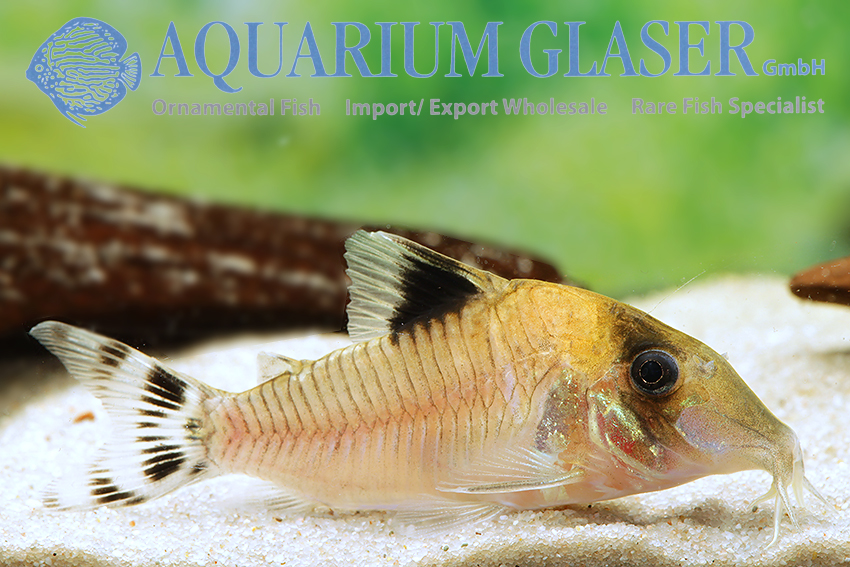
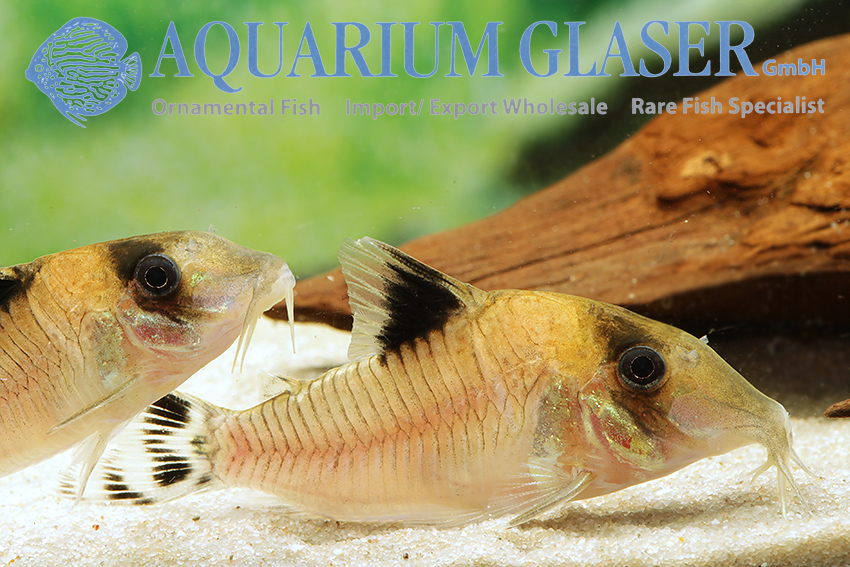
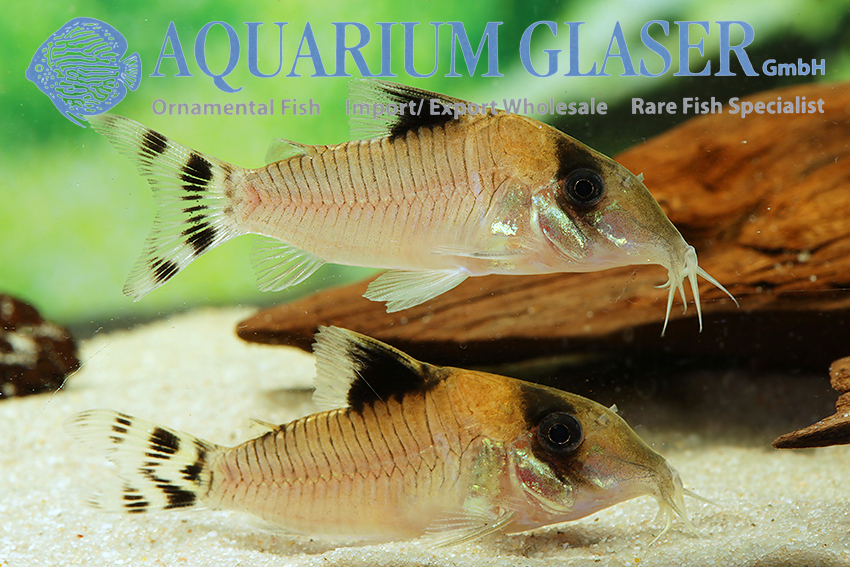
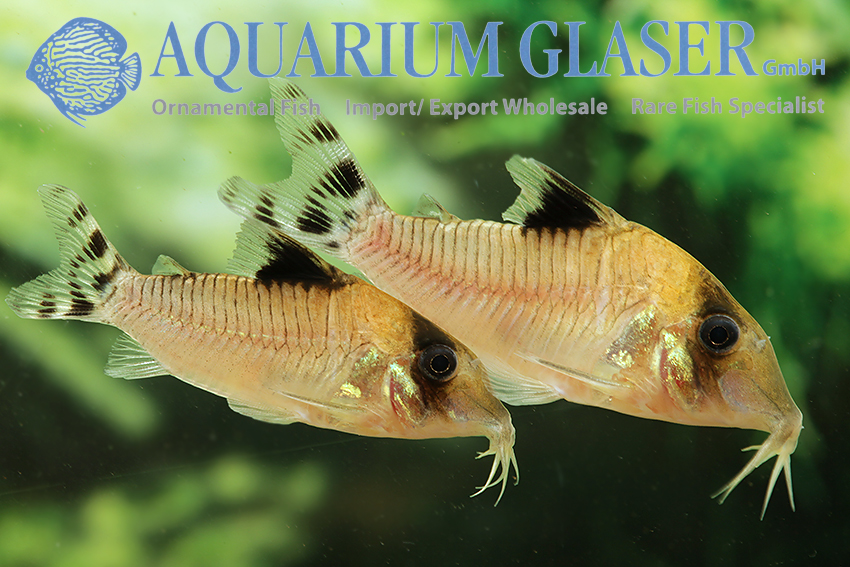
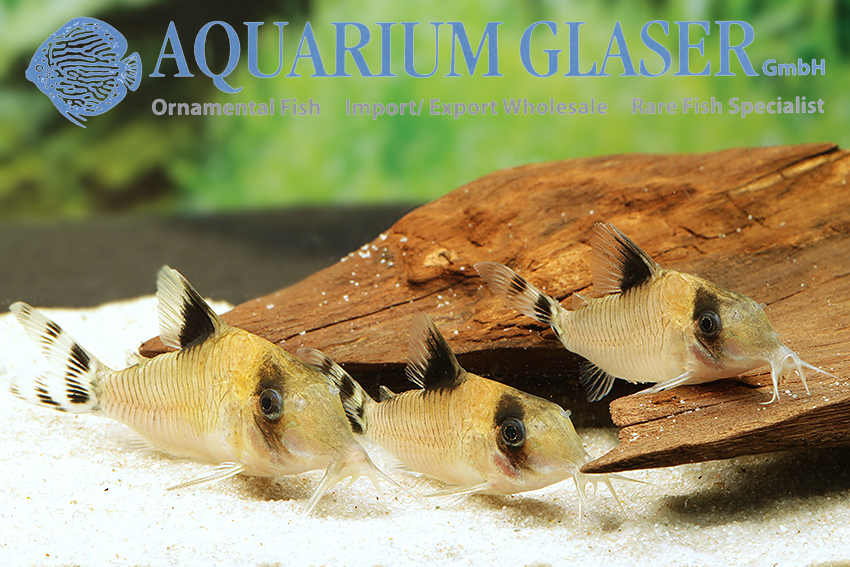
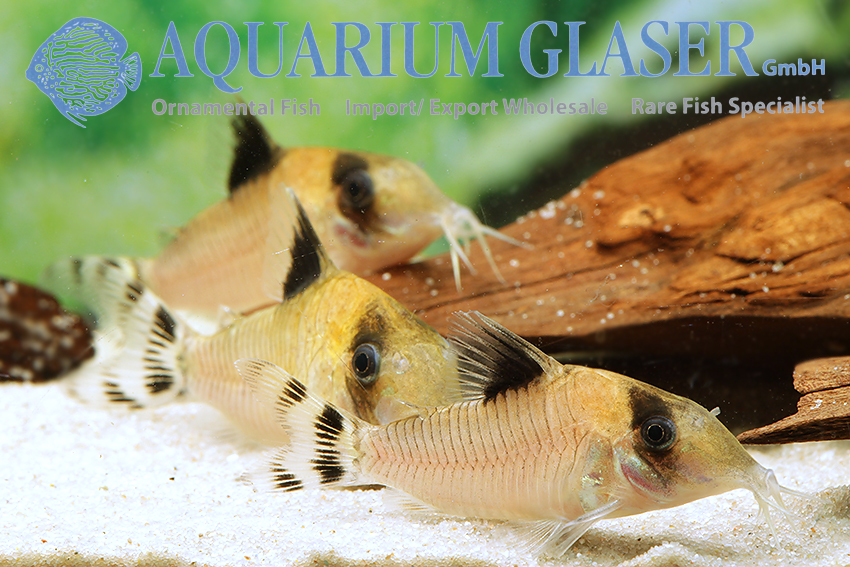
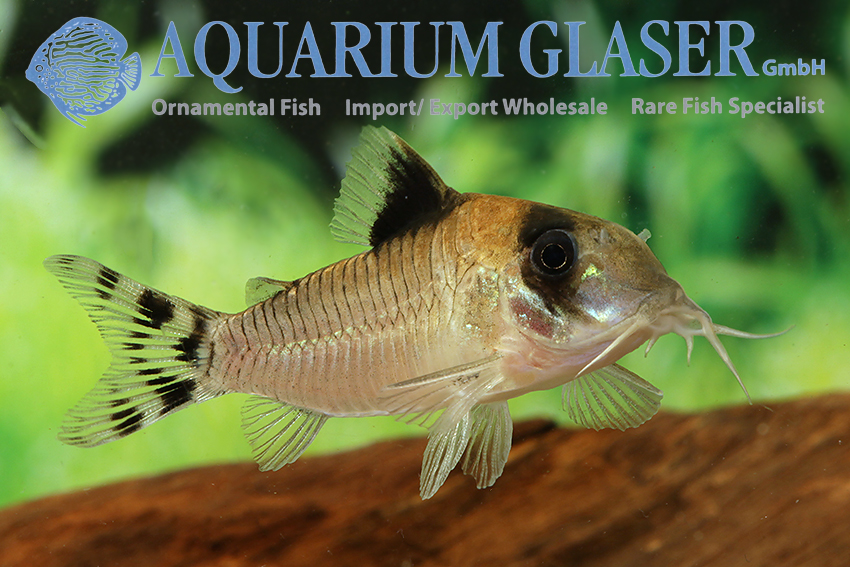
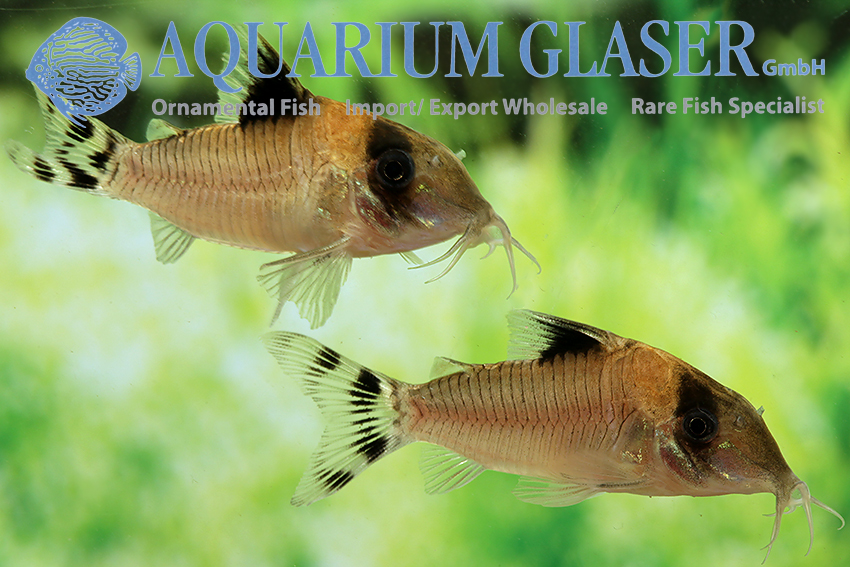
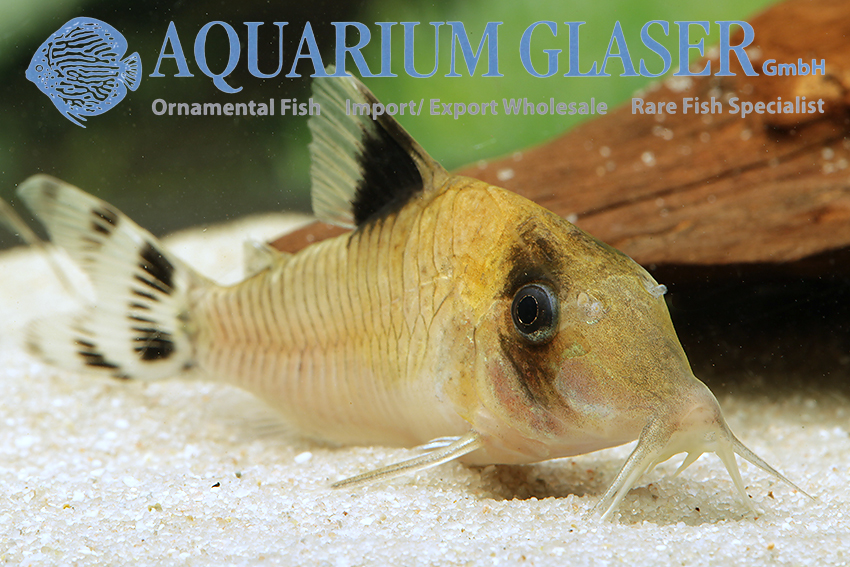
These two armored catfishes occur together in the Rio Oyapock in French Guyana; the species name condiscipulus means „schoolmate” because the two species swim together. There are hardly any ornamental fish exports from French Guyana; it is usually too expensive. But fortunately the Oyapock also flows in neighboring Brazil (state of Amapa) and so specimens from there come to us from time to time. By the way: we also received C. oiapoquensis, maybe more about that later…
For our customers: the animals have code 226105 on our stocklist. Please note that we only supply wholesale.
Text & photos: Frank Schäfer
Ancistomus cf. sabaji L75 offspring
We have received very nice offsprings of L75, which are currently 6-8 cm (26480-L 075x-2) and 10-12 cm (26480-L 075x-4) long. Here the report of the breeder, for which we thank very much:
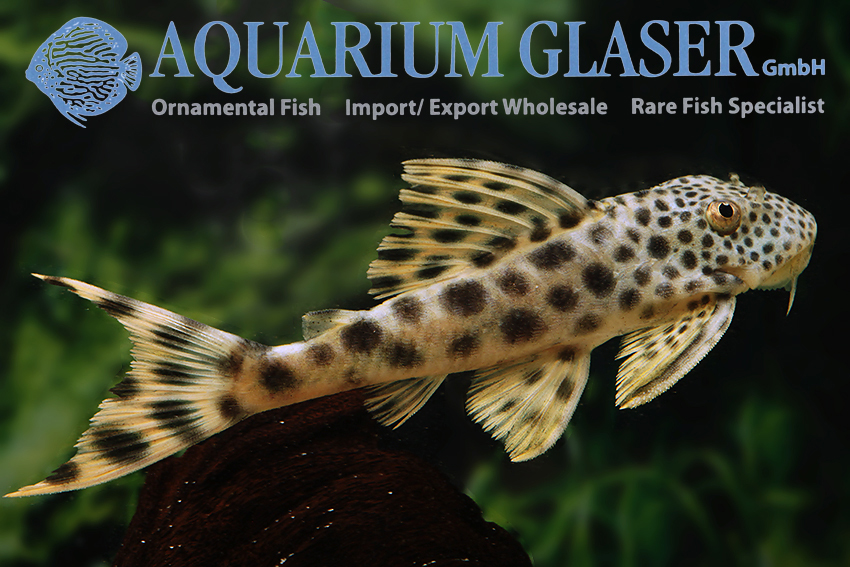
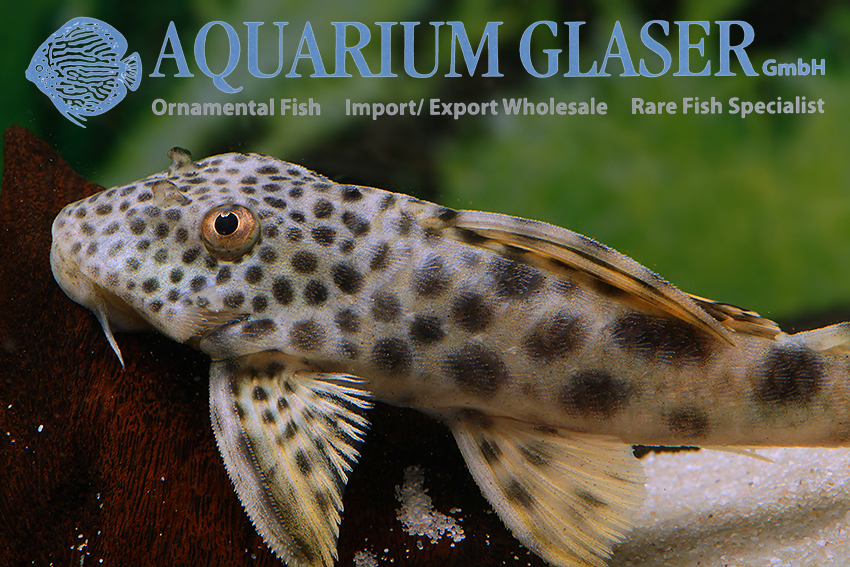

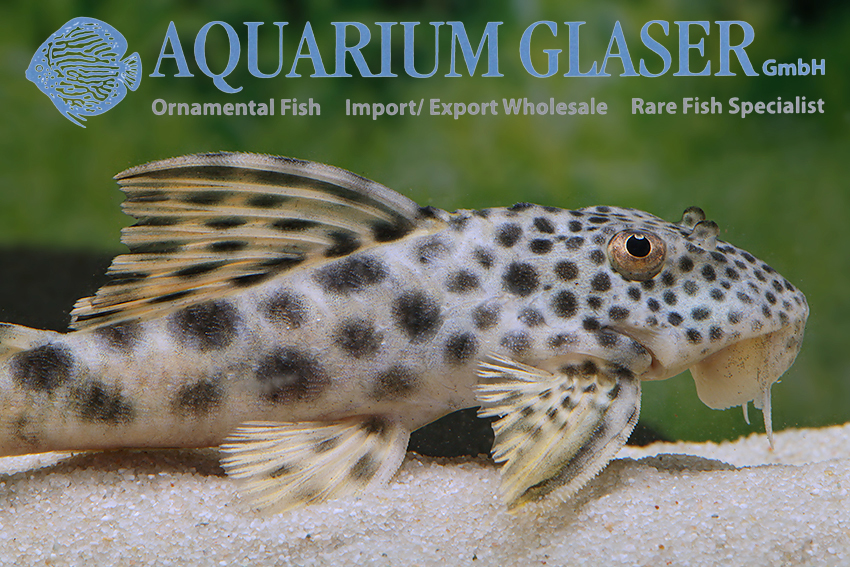
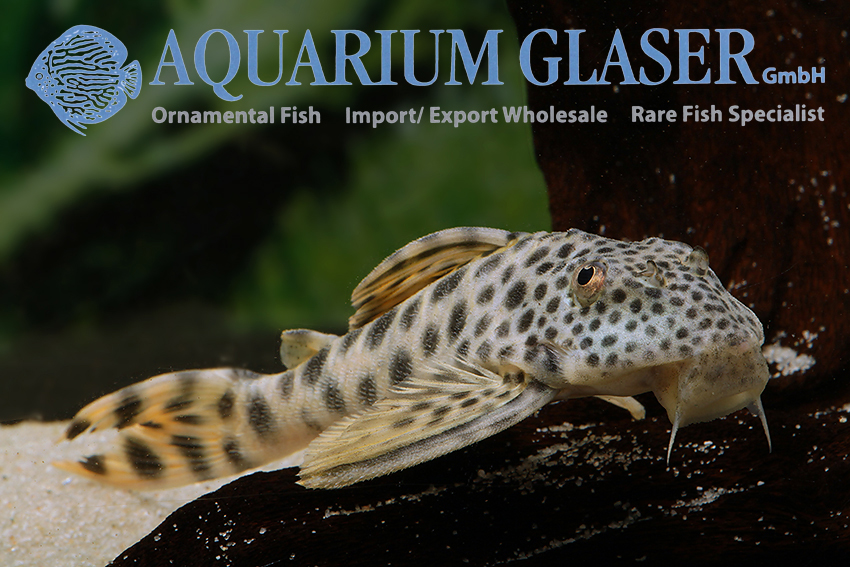
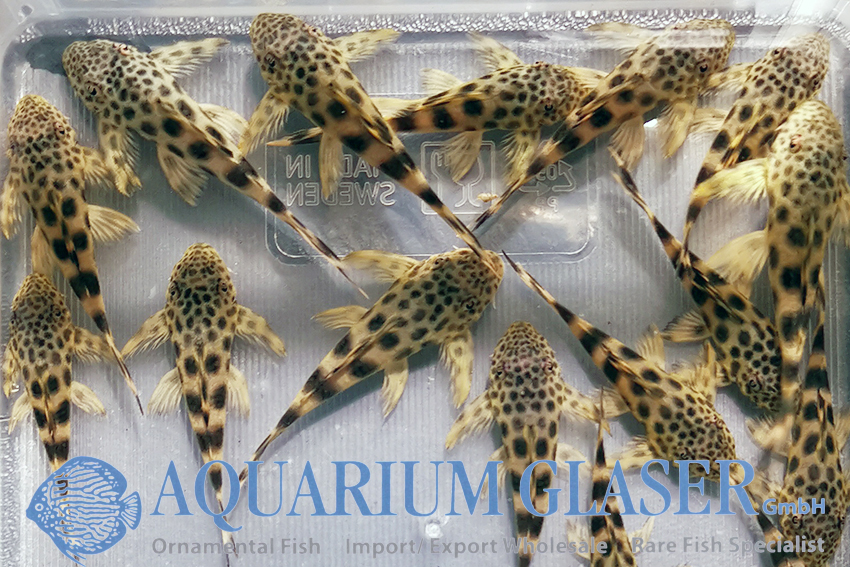

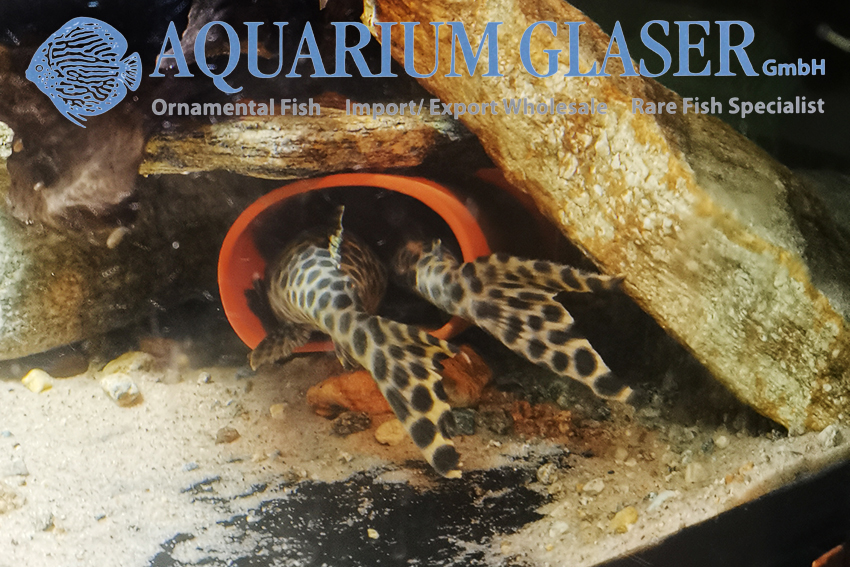

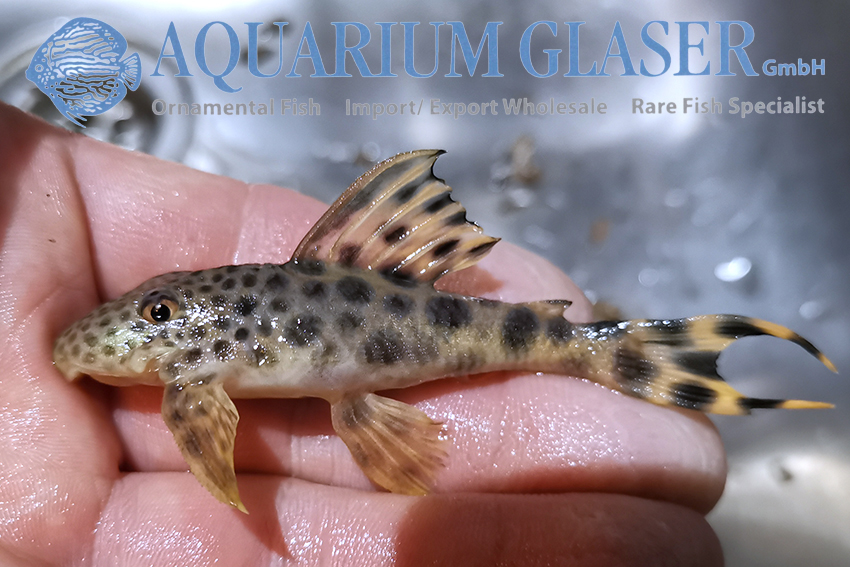

Breeding report Ancistomus cf. sabaji L75
Until breeding L75 was a long way. I tried it for seven years with two groups. It turned out: patience is always the key to success with difficult plecos.
L75 is a pleco that has fascinated me for some time, so I was happy when I got three adults (two males and one female) in 2014. I had no success with this group, but six years later, in 2020, I bought seven more. Things went very quickly with this group. Several of the males showed interest in the caves, and I was happy to soon find one on a large clutch. The fight for the cave with other males stressed the brooding animal quite a bit, and after 3 days he threw the clutch out of the cave.
I managed to recover about fifty eggs, but because of a fungus, only six hatched, all of which fortunately survived. Later I removed four adults, so I ended up with the breeding male and two presumed females. Further reproduction now went very well, with the male mating with both females and taking care of the eggs and young, this time without disturbance.
The adults are 20-25 cm and are fed an insect-based diet with some fresh fish and mussels. Soft, neutral water, 28-30 degrees Celsius. The number of eggs per clutch was 150-250, depending on the size of the female. The fry grow very well on a varied diet under the same conditions, are gray at first and get the leopard pattern at about 3 cm. All in all, due to its more active behavior compared to other plecos, L75 is a very entertaining species whose care and breeding can only be recommended.
Knut Hatteland Sømme
Corydoras melanotaenia
Because of its bright yellow fins Corydoras melanotaenia surely belongs to the most beautiful armored catfishes at all. It is, so to speak, the long snout to the bronze cory type, which can be found throughout South America. In contrast to its ubiquitous cousin, C. melanotaenia is an endemic of Colombia, i.e. it occurs exclusively there.
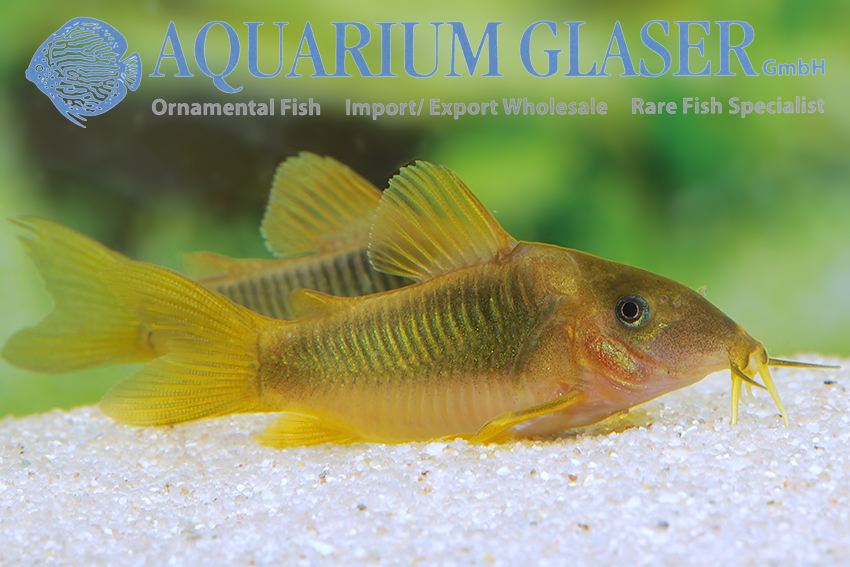


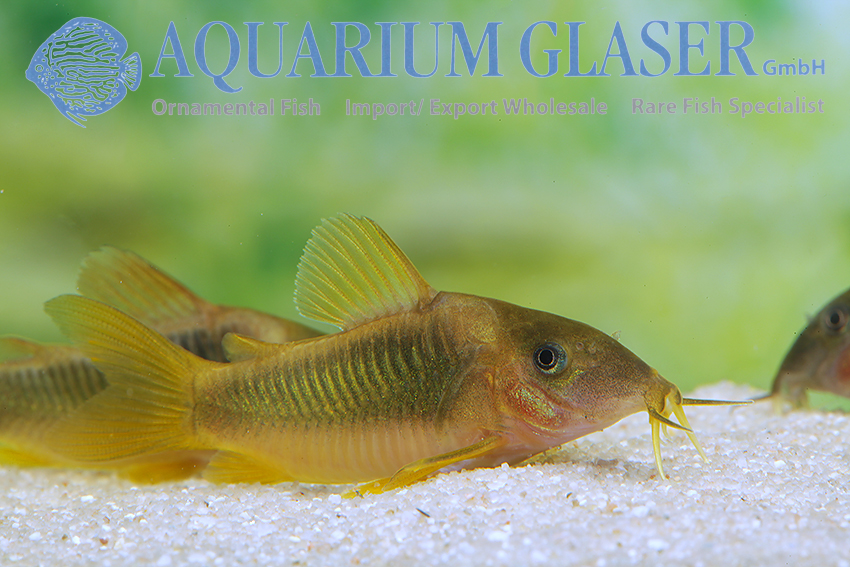
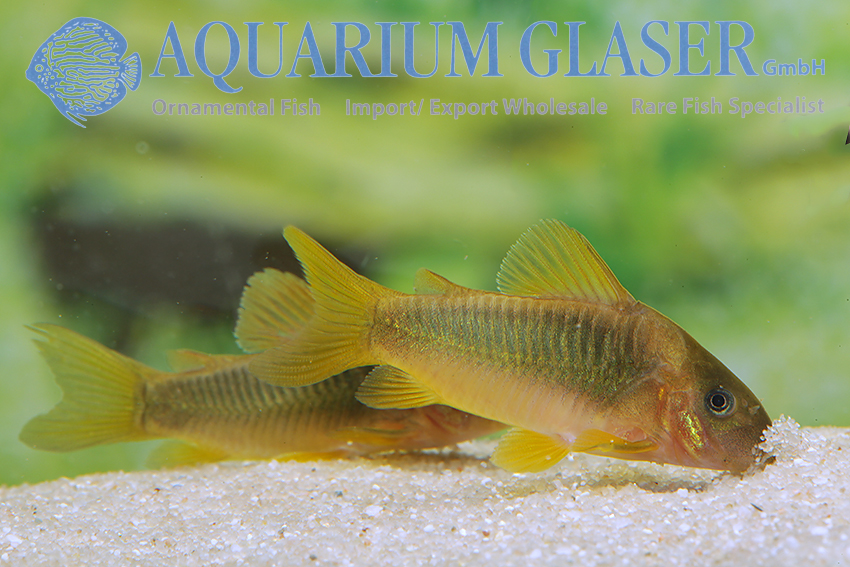
The origin of C. melanotaenia, which was already scientifically described in 1912, was unclear for a long time. It is said that the animals on which the first description was based were caught in the Rio Magdalena basin, where later expeditions searched for them in vain. Already in 1922 it was assumed that the type specimens were sent to London via Honda (this place is located at the Rio Magdalena), but in reality they came from the Rio Meta basin. In fact, to date, not a single species of Corydoras has been reported from the Rio Magdalena and it is generally agreed that C. melanotaenia comes from the Rio Meta basin.
This Corydoras grows to about 5 cm and has all the positive characteristics that make Corydoras so popular in the aquarium: a lively and completely peaceful nature and uncomplicated keeping.
For our customers: C. melanotaenia has code 235503 on our stock list. Please note that we supply exclusively to wholesalers.
Text & photos; Frank Schäfer
Nemadoras humeralis
The thorny catfishes are a very interesting and diverse group of catfishes. We were able to import from Peru the species Nemadoras humeralis, which can reach a total length of about 15-20 cm. At first sight the fishes remind very much of the Hassar species, which they also resemble in behavior. They are peaceful schooling fish that move around a lot and appreciate some current in the aquarium.
Nemadoras are omnivores that can be fed on all common aquarium fish foods, although the emphasis should clearly be on a meaty diet. Water composition plays a minor role in their care. You can maintain the animals in any tap water.
The aquarium for Nemadoras should have plenty of free swimming space. Plants will not be damaged, but with very dense plant growth there is a risk that the fish will become entangled in the underwater plants. Nemadoras are ideal community fish for larger aquariums with tetras etc.
For our customers: the fish have code 272484 on our stock list. Please note that we supply exclusively to wholesalers.
Text & Photos: Frank Schäfer
Kryptopterus vitreolus
The common glass or ghost catfish, Kryptopterus vitreolus, has been swimming in numerous aquariums around the world for decades, albeit mostly under the misnomer K. bicirrhis (see https://www.aquariumglaser.de/en/fisharchives/a_new_name_for_the_ghost_glass_catfish_kryptopterus_vitreolus_en for details). We have the animal practically always in the stock.
One of the absolute routine measures in the everyday care of the fish is to examine it regularly in the beam of a strong flashlight for possible disease. In this context, one of our keepers, Martin Möller (who has a degree in biology), made the discovery that under certain light incidence, the glass catfish show a distinctly colorful iridescence. This is basically the same effect of light refraction that leads to the formation of rainbows. However, it is not easy to capture it photographically, because the interaction of light and movement of the fish must fit absolutely. After many unusable pictures, however, we finally succeeded in depicting the Möller effect. Fascinating, to say it with Mr. Spock!
For our customers: the animals have code 422005 on our stock list. Please note that we only supply wholesale.
Text & photos: Frank Schäfer
- « Previous Page
- 1
- 2
- 3
- 4
- …
- 8
- Next Page »





